#watching his speech with the NAACP today
Explore tagged Tumblr posts
Text

Biden previewed the shift in a Zoom call Saturday with the Congressional Progressive Caucus. “I’m going to need your help on the Supreme Court, because I’m about to come out — I don’t want to prematurely announce it — but I’m about to come out with a major initiative on limiting the court … I’ve been working with constitutional scholars for the last three months, and I need some help,” Biden said, according to a transcript of the call obtained by The Washington Post
Four days after that debate, the Supreme Court ruled that Trump was immune from prosecution for official acts during his first term in office. Less than an hour later, Biden called Laurence Tribe, a constitutional law professor at Harvard Law School, to discuss the ruling and the arguments for and against reforming the court.
Biden continually works with really smart people in the background, quietly, until he's ready to do or announce something. He uses these tactics in negotiations with other countries as well. He's not bombastic nor does he make the media happy because he's boring, but he's effective.
Whether you like him or hate him, he's actually good at this job and he gets shit done and often times it's actually good shit.
#US Politics#that wapo article is definitely slanted against biden#but this is some good shit#watching his speech with the NAACP today#and next person who says he has dementia gets fucking slapped with a trout
288 notes
·
View notes
Text
MARCH 2025
THE RIB PAGE
Hooray for Amber Ruffin. One of the most talented writers and performers today will host the White House correspondent’s dinner. Step by step, the women will save us. That is, if this even comes off. Scary Clown 45/47 is cancelling everything else so why shouldn’t he get his fingers into this pie? Go Amber... give ‘em Hell!!!! ** Also.. So glad to see her back on Roy Wood’s Have I got news for you. That show is off to a fab start with Andy Richter!!!!!!!!!!!!!!! ** Amber also hosted the African American film critics association awards and she looked great!!! Winners included Colman Domingo, Marianne Jean- Baptiste and Clarence Maclin. ** Do you all remember the good old days when you were proud to say, “My President is black. Now, it’s my President is a South African Nazi oligarch”. - Amber Ruffin
*****
It sounds like the Rolling Stones will now not be touring this year.
*****
So excited for George Wallace and Laverne Cox in Clean Slate !!!!!!!!!!!!!!!!
*****
The Grammy’s were watched by more folks than usual. My best dressed were Wayne Brady, Brittany Howard, Norah Jones, Jacob Collier, Kelsea Ballerini, Sabrina Carpenter, Billie Joe Armstrong, Taylor Swift, Cynthia Erivo, Miley Cyrus, John Legend and Shenseca. Bianca Censori came to shock. Seeing Jaden Smith reminded me of Don Cheadle in Boogie Nights. So sad. Those Smith kids always seem to try way too hard. Beyonce won big! Other winners included The Rolling Stones with Hackney Diamonds, The Beatles, Jimmy Carter, St. Vincent, Lucky Daye, Doechii, Norah Jones, Bob Marley and Jon Batiste.
*****
Ontario has ended their contract with Starlink.
*****
Days alert: If they ever make a Taylor Swift bio, they should consider the current Stefanie Johnson!! She has that energy. ** I am still seeing Joy and Aaron. Is Joy in LA or is she still around? Bring Aaron back!!! I will miss Seth Burns. ** So glad to see Alex and Stef. Finally!! ** Former Days actor Casey Deidrick was arrested for domestic assault. ** Hank Northrup learned on his birthday that he will be joining Days. His first scene is with James Reynolds. ** Why do I like Belle and EJ together so much? *8 They did a great job with the Rafe switcheroo.
*****
Costco averted a strike. ** Hooters filed for bankruptcy.
*****
Tituss Burgess is taking the lead in Oh Mary! Cole Escola is on the way back!!
*****
We didn’t do the Chuck E. Cheese crap. - Letterman on the Tonight Show
*****
Denny’s and JC Penney are closing some locations. Hooter’s is filing for bankruptcy. Costco is opening more stores.
*****
The Independent Spirit awards came and went. Winners include: Anora, Baby Reindeer, Kieran Culkin and Shogun.
*****
The NAACP awards honored Kamala Harris and The Wayan family. My best dressed were Ayo Edebiri, Halee Bailey. Laverne Cox and Kamala Harris. Winners included Martin Lawrence, Kerry Washington, Quinta Brunson and Queen Latifah. ** Harris’ speech was inspiring. Perhaps she needs to be out there on the sidelines being a leader and giving us strength.
*****
Dorian Harewood is going to have his first solo show in NY as a singer. Proceeds will be donated to fire relief and CORE. His daughter lost her home in the LA fires.
*****
Steve Bannon pled guilty to fraud and cut a deal so he won’t serve more prison time.
*****
Get ready for Mindhunter season 3.
*****
The new Dolly Parton musical, Here you come again is hitting some snags. The show, about a gay, artistic Dolly fan is freaking out some of her fans. ** There are also efforts to cut her imagination library.
*****
Lester Holt is leaving the NBC Nightly News.
*****
Hooray for the Park workers who put an upside -down flag in Yosemite. Other parks are getting creative and it is only the beginning.
*****
SNL had its 50th with lots of specials. It was fab to see so much talent. The show changed our lives forever and so many have participated in the love and laughs. I so wanted to see Rickie Lee Jones on there but at least Jack Nicholson and Keith Richards and Patti Hanson were there!! All in all, though, what a celebration. Hader, Akroyd and some lesser knowns were sorely missed. It was a shame that Dana Carvey could not come for Wayne’s World but it did free up Mike Meyers for Linda Richman. I wish I could have seen more Jane Curtin who is my all- time favorite player but it was just good to see her. BTW, lighting up weed on stage will not make us like you again. And who sat Rob Schneider next to Rev. Al? And how did Wally the cue card guy get into a controversy? ** And why is Lorne so seemingly obsessed with this Shane Gillis person? First show back and here we are again. There are so many potential hosts out there. Is it because the suits made you fire him?
*****
Lionel Richie has written Truly.
*****
Israel has been accused of ceasefire violations.
*****
Kathy Griffin has a new You tube show, Talk your head off. Go girl!
*****
Kanye is selling Nazi T’s.
*****
I know his is nitpicky but there is a new T-mobile ad with SNL’ers but all I can think of when I see it is The Monkees and Opera man. Was this intentional? Keenan’s, “Listen to the song” is dead on Papa Nez on Listen to the Band. And some of the jingle sounds very Sandlerish.
*****
The BAFTA awards came and winners include A Real Pain, Conclave, Anora, Kieran Culkin, Wicked and Zoe Saldana. My best dressed were Kate Green, Colman Domingo, Marianne Jean-Baptists, Jeff Goldblum, Emilie Livingston, Zoe Saldana and Warwick Davis.
*****
The Met Gala theme this year is’ Tailored for you’.
*****
The reboot of Day of the Jackal was awesome. Can’t wait for season 2. ** Peacock has also brought us The America’s. It felt like Sunday nights of the past when Cousteau and Disney enthralled us with nature. This country needs a show like this right now. Some need to be reminded of the beauty of these lands.
*****
Matt Rhys is set to star in Widow’s Bay.
*****
Utah has banned unions from negotiations.
*****
The very avoidable measles is up to over 100 cases now.
*****
23X1 Racing and Front Row Motorsports will get to compete this year, despite lawsuits and not signing the new charter. An injunction lets them race. These drivers include Bubba Wallace, Riley Herbst, Tyler Reddick, Noah Gragson, Todd Gilliland ad Zane Smith.
*****
Ken Martin is the new DNC leader.
*****
Marcus Jordan was arrested for Cocaine possession, DUI and resisting arrest.
*****
The Rock and Roll Hall of Fame announced nominees. The list includes Bad Co., The Black Crowes, Mariah Carey, Chubby Checker, Joe Cocker, Billy Idol, Joy Division/ New Order, Cyndi Lauper, Mana, Oasis, Outkast, Phish, Soundgarden and The White Stripes.
*****
A Loretta Lynn musical is in the works.
*****
Killer Mike has sued S&S labor force from events at last year’s Grammy’s.
*****
Howie Mandel has apologized for his Bill Burr faux pas, saying, “I feel horrible.” Yea, you should.
*****
Civil disobedience is better than Botox any day. - John Waters
*****
The shooting in Sweden is a bad sign that the rest of the world may be starting to follow our lead.
*****
If K-12 schools require Covid vaccines, they will no longer get Federal funds. I’ll bet that made RFK Jr. Happy.
*****
Stephen King went back on X: Just wanted to say that Trump is a traitorous, Putin- lovin' dip shit. Goes double for Elon. - S. King
*****
The Critics choice awards went to Kieran Culkin, Demi Moore, Zoe Saldana, Anora, Conclave, Jon M. Chu, Shogun, Deadpool and Wolverine, A Real Pain, Kathy Bates, Hacks, Hannah Einbinder, Squid Game, Colin Farrell and Ali Wong among others.
*****
CBS had to hand over documents to Trump’s team from a Kamala Harris interview on 60 minutes.
*****
Aaron Rodgers is out at The Jets. Yes!
*****
The SAG awards were very good. My best dressed were Cynthia Erivo, Monica Barbaro, Kieran Culkin, Jeremy Allen White, Zoe Saldana, Timothee Chalamet, Paul W. Downs, Mikey Madison, Keke Palmer, Selena Gomez, Colman Domingo, Michelle Yeow, Lily Gladstone, Quinta Brunson, Jane Fonda, Bowen Yang, Leighton Meester, Michael Urie, Marissa Bode, Janelle James, Mille Bobby Brown, Sofia Carson and Nicola Coughlan. Winners included Martin Short, Kieran Culkin, Colin Farrell, Jean Smart and Zoe Saldana. Jane Fonda won for a lifetime and gave us the speech we needed. ** Woke just means you give a damn about other people. - Jane Fonda
*****
Did they solve that crazy dog and cat eating problem??
*****
Amazon MGM has taken control of the Bond franchise.
*****
The Humane society of the U.S. (not your local Humane Society) is now Humane world for animals.
*****
We are bleeding out. - Samantha Bee
*****
RFK Jr. and Tulsi are in so there ain’t no time to wonder why. Whew.. We’re all gonna die!!
*****
It wasn’t pedophilia. - RFK Jr.
*****
CBS Sunday Morning seems less diverse all the time.
*****
Kid Rock and Lauren Boebert? That sounds about right.
*****
I can’t wait for Mid-century modern with Matt Bomer and Nathan Lane.
*****
Maine Gov. told Trump she would see him in court. Maine is now being investigated.
*****
I was watching an old documentary about Jewish comedy that was made pre-2015 and it is amazing the difference in culture. Old comics were telling how tough it could be for them in the past and that it is so much better now. It just shows how quickly a country can change back to prejudice. Oh, it was there but a bit more in the shadows. Now, people are proud to tell you how full of hate they are for “the others”.
*****
Ok, so this one fucks with my head. Word is that there is a surging demand for breakfast in eateries. Egg prices are already high and this just pulls supply down even more which in turn hikes up prices more. Is it that humans hear that they may not have something or it is harder to get and that makes them want it all the more? Are we children? Just lay off the eggs for a bit. There are plenty of other things to eat and lots of substitutes for cooking so take a little break until things balance out. WTF?
*****
Tesla Swasticars : Goes from 0 to 1939 in 3 seconds.
*****
You know what a bully is? - Donald Trump
*****
Well, there is just so much about the state of our country which is, I guess, On Fire!!! I so don’t want to talk about this fascist anymore but here we go: I was hoping that somebody would do a sort of Nite line daily update in regards to the current administration. There is so much crap going on that we need to keep a list and follow up. They so love to drop a bomb and walk away. There are so many lies. Well, I did hear of one keeping the scorecard: Trump tyranny tracker. Let’s go!
*****
Stop the steal. - Schumer and Jeffries. We really do need you to do more.
*****
JD Vance thinks men are suppressed by the U.S. culture. What? How ineffective of a man must one be to be so threatened. It makes sense that they want to push the oppressed further down. They are all bravado, no substance. Will their voters ever realize the depth of the damage they have done?
*****
JB Pritzker gave a great speech full of great insight and information. Illinois is #2 in the nation for corporate expansions and relocation destinations. He called out the idiocy of the administration. High school graduate rates are at an all- time high. ** It took the Nazi’s one month, 3 weeks, 2 days. 8 hours and 40 minutes to dismantle a constitutional republic. - JB ** At the end of the month, the Gov. Was on the View. His call to the country as to what we are living thru is important. Some people in charge are not going to put up with this shit.
*****
Here is some of what we have lost as they attempt to “delete entire agencies.”: US Fed websites took down LGBTQ+ health info. Just about anything to do with diversity and vaccines is gone. Tons of food went to waste as it was waiting to be delivered. The administration would not let USAID deliver. At least now we all know how great USAID is. Now we know what they do and just how important it is. I am sure there would be ways to tweak it but just being cruel is not the way. They do not even seem to be paying for work that has already been done. Typical Trump behavior. How many citizens has he not paid for services rendered? Our country is much less safe since he is letting criminals out of prison. He sends foreign criminals out of the country and lets ours go free. Could he be building a secret army? El Salvador has offered to take our criminals. ** OSHA may be out. CFPB may be out. FEMA? Good luck on our next disaster, work related accidents et al. These will be huge blows. They seem obsessed with the idea that many Fed workers don’t even exist. They do. This could work for them to take us off the SS roles too. We banned the mail from China and then that was off. How many things have been declared and rescinded? And think of the workers who have to work double time to catch things up. More than a million packages were waiting after Trump ended duty free entry for Chinese goods. A bunch of little spoiled rich boys who never learned to share. It is like they are playing with the world as if we are their toys. This is not their personal piggy bank. The Government should not be run like a business. How does $ mean more to them than dignity, compassion and respect for fellow Americans? The arrogance of these folks! I wonder if Trump were President instead of Andrew Johnson after the Civil War, would he have signed an executive order to bring slavery back? Our anthem is being booed by other countries. The rest of the world is not indoctrinated into Fox et al and are calling us out. They will really see the insanity that half of this country has had to live with since 2015. The Trump administration really seems to hate people. Did you ever think you would see the day that an administration was tracking down conspiracy theories? It hasn’t been this wacky since The Reagans and their astrologer. It is only a matter of time before they start rounding up the Jews, the gays and the atheists. ** By taking away all the info, he does his best to make not just half of the country uninformed but all of us. It is hard to fact check when the facts are hidden. We have been shouting the truth from the rooftops but until the Fox wall comes down, it does no good. It is going to be up to the Dr’s and teachers to inform us. Is Karma all we have left to believe in?
*****
DOGE has fucked up so much and are trying to take credit for things they had nothing to do with. An example is telling us they cut allowances for former Presidents when that was because President Carter died. So, the man was very aged but did they kill him? What did they do to take credit for this? ** And how could they let Forest rangers and park employees go. They not only keep an eye on bathrooms, fire et al but just imagine the animals slowly creeping in and taking over as they will. That does not sound safe to me. Just because they don’t enjoy the wonders of nature, does not mean the rest of us don’t.
*****
The Tate brothers who have been accused of human trafficking in Romania. They are big Trump fans and are back in the U.S. Certain kinds of criminals are very big with the President. We may be able to get rid of them because the UK has issued a warrant for them.
*****
He is flooding our streets with criminals. - JK
*****
Mexico is extraditing Rafael Caro Quintero and 28 other suspected Cartel members.
*****
Before he went to the hospital, the Pope was arguing with Cardinals over the direction of the finances of the church.
*****
Gayle King, Katy Perry and Lauren Sanchez are gonna go to space in the first all -female crew. Bezos is trying hard not to look like a creep. ** And, why is Bezos paying millions to Melania to make this Ratner film? Just ass kissing?
*****
Did ya see that cabinet meeting? What a room full of white garbage.
*****
The whole abortion subject is starting to pit states against one another. Federal law is so important here. The militant wing of the Christians will not back down. We need to UNIFY. Patchworking this country more won’t do it.
*****
There is actually a name for the republican, plastic women around the Trumpers. Word is that Fla. plastic surgeons are calling the red clothing and fake face the Mar A Lago look.
*****
So we have Dark Maga?
*****
The Super Bowl winning Eagles said, ”No thanks” to a White House visit.
*****
Colbert has reminded us now that WE are part of the axis of evil.
*****
I wonder how long does it take to radicalize the average MAGA follower? Do they realize the Trump speak (ex: radical lunatic = humanitarian). How many get the codes? I guess it isn’t even code anymore when President Musk just ‘Heils” like he does it every day. I mean if you don’t feel bad about a President who is in favor of ethnic cleansing, then I suppose there is no hope for you. The man loves to be adored but he loves fear and conflict. Holding back aid from the poor should start to kill us off nicely. Governments CAN help people just like churches and the private sector. Not everyone wants to be preached at just because they are poor. Why do they love to watch others suffer and why do they seem so gleeful about it? They get such pleasure at how upset we are. Republicans have introduced legislation to increase bank fees. Really? ** We should not be surprised by the Gaza strip proposal. Jared Kushner was talking a year ago about moving those people out of Gaza and making luxury beachfront crap. C’mon, pay attention! ** Scary Clown wants to make us believe that Ukraine started Russia’s war. How long until Zelensky is in prison? Who will be the first good ol’ boy American to put the Russian flag in their yard? You know it’s coming.
*****
The less talent they have, the more pride, vanity and arrogance they have. All those fools, however, find other fools who applaud them. - Erasmus
*****
These companies seem to be complying or supporting the current administration. They should know how we feel about that. Supporters or donors to Trump include Jimmy Johns, Home Depot, Excel, Chevron, Penske, Exxon Mobil, Amazon, Meta, Uber, Boeing, Bayer, Comcast, Verizon, PayPal, Coke, Arby’s, Alamo, Auto Zone, Bacardi, Cold Stone Creamery, DQ, Boost Mobile, Buffalo Wild Wings, Buick, Cadillac, Carl’s Jr., Charmin, Chevy, Chiquita, Chobani, Coors, Cuisinart, Dean Foods, Dole, Dunkin’ Donuts, Wal Mart, Wendy’s, Wonder, Turtle Wax and Sunoco. Let’s support those companies that embrace their DEI and are standing tall in their resistance. Hooray for Costco, Ben and Jerry’s, Jamba, Ulta beauty, Dollar Tree, the NFL, Goldman Sachs, Apple, Cinnabon, TJ Maxx, Auntie Anne’s, Kroger, Moe’s and JP Morgan.
*****
I wanna call France Kenny. - Andy Richter
*****
It didn’t hit me until later that so many in this country hated the “work hard” cry from Kamala Harris. Some folks actually have to do the hard work in this country. The cell phone age seems to breed instant results and trouble with time management. A friend mentioned that he can barely watch movies alone anymore because he can’t concentrate that long. I see the pain and apathy all around me. Entire lives are changing and not for the better.
*****
Isn’t it strange how most look so nervous around Scary Clown except Musk. Trump almost seems a bit leery of him. Is it true that Elon’s nephew is his half- brother? Word is that his Father had a baby with his stepdaughter. And isn’t it strange that the rise in gambling is taking place at the same time as this greedy takeover of our country. Sometimes it can feel like there are no people left who want the simple things. Why do ya’ll need so much? ** We have seen the largest increase in consumer pricing in one and a half years. ** I can’t believe we are back to watching a President hold up his signature that he is so proud of. Are these people even capable of doing the right thing? It isn’t just chaos and heartlessness; it is also incompetence. And why is nearly every republican rubber stamping? The WH usually has to do some negotiating with Senators et al. But these cultists fall right into line. ** Perhaps the AP should be glad they are banned, it is all lies anyway.
*****
And Bill Maher tells us it is impossible to enjoy the ‘69’ position. What the fuck is he talking about? Who wouldn’t enjoy that?
*****
We will be losing a lot of money now. A lot has been lost already with Trump visiting sporting events and having himself a time while prices just keep going up. The President is making big $ with his coin and the $25 mil from Meta and the $10 mil from Twitter. It goes on and on. The man is worrying so much about what things are called and what color his plane is that nothing is really getting done. Fort Liberty to Fort Bragg? What? I don’t think too many of us even know who WW II’s Roland Bragg is. Oh it seems like a lot is going on but most things have been stopped by courts or reversed. Tariffs will make things even more expensive. Services are being manipulated which will hurt farmers. I wonder why there is so much mental illness now in the White house. What is the main reason for not understanding science? Is it bullying? Religion? Poor education? Just plain denial and greed? ** I wonder how much President Musk’s boy band, Akash Bobba, Ed Coristine, Luke Farritor, Gautier Cole Killian, Gavin Kliger and Ethan Shaotran are earning. ** They are saying we will all have to be on X eventually because that is how they will communicate all official shit. I can’t believe how anybody who isn’t a racist is still on the site. Why? It seems that Musk, the sociopathic tech doofus is getting many of his ideas from fellow X users. Idea man? Ok.
*****
It looks like former Viking player, Chris Kluwe was arrested for disturbing an assembly in California. His peaceful protest was about a plaque the library wanted up that spelled out MAGA. ** MAGA is a NAZI philosophy. - Chris Kluwe
Mitch McConnell won’t run again.
*****
Immigrants aren’t stealing jobs, the President is. - protest sign
*****
NY Mayor Adams has jumped on the Trump train with a loudly confessed quid pro quo that was quickly denied. Trump seems to really love those like- minded criminals. At least better than he likes Vice Presidents. 7 prosecutors resigned and Adams fate is still uncertain. An election is on the way but until then a Judge cancelled his trial but left the charges intact.
America does not seem to support Taiwan or Ukraine anymore. And Israel just got a gift of heavy bombs from Trump. The harm we do to other places will come back to haunt us. None of this is good for anybody except the dictators. Scary Clown 45/47 is doing everything he can to join that club.
*****
The Oval Office visits are sick. Macron should file assault charges with the way Trump was feeling up his knee. ** It looks like President Zelenskyy was set up. JD Vance said nearly as much. Scary Clown and his #2 berated the man. The complete disrespect for Zelenskyy showed that they now think they have an ‘excuse’ to give Putin what he wants. Trump gets so upset when somebody puts down his bud, Putin. Why doesn’t Trump tell Putin to stop fighting. If Ukraine stops, Russia will roll right over them. President Zelenskyy’s approval ratings are better right now that Trumps. Jealous? Our fearless leader is a vindictive ass. At least Vance admitted that Russia was the invader before Marco Rubio threw The Ukranian President out.
*****
Democracies don’t last forever. - Chris Murphy
*****
A$AP Rocky was found not guilty.
*****
Sheryl Crow sold her Tesla and gave the $ to NPR.
*****
I like omelet’s better than sex. - Sen. John Kennedy
*****
Believing that billionaires are fighting for the working class requires a comical level of delusion. - Fairy News
*****
The President is bitching about a deal in Canada that he put in place last time. So, he wants to undo things that former Presidents put in place, including his own? He seems to hate the Dept. Of Ed from Carter, the four freedoms and SS from FDR, US AID from JFK and on and on. ** He is also unhappy with NBC and the AP. Pretty soon there will only be Breitbart and Fox and Rogan in briefings, on Air Force One and at the Pentagon. We do still have freedom of the press and editorial decisions are up to THEM. The man openly says that he does these things so his people won’t believe. He lives for keeping it confusing. ** He and his buds pulled a hostile takeover of the Kennedy Center. Many say it may be due to some recent drag shows there. Some have resigned as they have from the DOJ and well, from pretty much everything. Trump claims that he got rid of Board Chairman David Rubenstein but he was set to retire in January anyway. Artists are cancelling shows left and right. Again, he is fucking with people’s livelihood. There is some federal funding but is there a way to privatize it more so this can’t happen? What will happen to Conan’s Mark Twain Prize??? He always gets screwed. I am sure that Lara Trump, the Jan. 6 choir and Lee Greenwood will be up next for honors. After I wrote this, I saw others making the same forecast.
*****
How many cult-47ers does it take to screw in a lightbulb? None. He’ll just proclaim it’s already fixed and they ‘ll all applaud in the dark. - U.S. Dem Socialists
*****
If a person says it’s raining and another insists it’s sunny, the media’s job isn’t to give them equal airtime. It’s to check the facts and tell us what’s actually happening. -U.S. Dem Socialists
*****
Gene Simmons is leaving X. Is that true? Did the Jewish hate on the site finally overcome his loyalty to Trump or does he see these as 2 different evils?
*****
When they try to silence you, it’s not because your voice is weak. They try to silence you because your voice is POWERFUL. Keep using it. - George Lopez
*****
Gold card to enter America? What in God’s name will he sell next? The Lincoln memorial? The Statue of Liberty?
*****
Town halls have been exploding. Dr. Borrenpohl was dragged out from one Idaho meeting. The private firm, Lear asset management has lost its license over the dustup. She has already raised $250,000 for legal fees. ** The Republican seem to have come up with a way to deal with these confrontations; less town halls.
*****
I hope America is as lucky as the upside -down Delta jet. Everyone survives but the right wing explodes. - Feminist News
*****
Some say that Trump looks more like an Oompa Loompa every day. It is still hard to believe some people think that Scary Clown 45/47 is cool. He and his people are about the most uncool people I can think of. He is not gangsta in the cool sense at all. Never once did someone show me that racism and greed is cool when I was growing up. What kind of monsters raised these people? There are some from Hollywood and the media that have caved but many stand strong. It isn’t all state tv yet. The banning of the books has started. Julianne Moore’s book is on the list. And are they starting to close the libraries of Democratic Presidents? ** Speaking of uncool, Jon Stewart mentioned that they need to stop trotting out Chuck Schumer. Yea, can we have AOC or Jazmine Crockett or somebody who really gets it? I feel a tsunami of liberals are on the way.
*****
I wonder if the right loves marriage so much because spouses don’t testify?
*****
So, the Transgender community can no longer participate in the military?
*****
The Federal civilian worker payroll totaled $271 bil. in 2022. The annual cost of permanently extending Trump’s tax cuts is about $400 bil. ** The National labor relations board had 24 investigations into Musk’s corporations for violating worker’s rights. ** We just handed millions to Space X. The state department tried to funnel $400 mil to Tesla. The FAA gave a Federal contract to Starlink, worth billions. Musk also recieved $38 bil in other government contracts, loans and tax credits. He is part of what he, himself calls, “the parasite class”.** The NY Times found that investors in Trump crypto have lost about $ 2bil. There have been some bad days at the NYSE.** 400 FAA employees were fired. We are having the biggest retail drop in 4 years. ** They also fired the chairman of the joint chiefs of staff, Gen CQ Brown Jr. Also let go were Lisa Franchetti and Jim Slife. A less qualified white man, Dan Caine is taking over for Brown. **I hate to think of how many elderly people are scared out of their minds right now. And leave the Post Office alone.
*****
Hooray for Brian Driscoll, the acting FBI director!!!!!!!
*****
We are an absolute laughingstock. - George Takei
*****
What the herd hates most is the one who thinks differently; it is not so much the opinion itself, but the audacity of wanting to think for themselves, something that they do not know how to do. - Arthur Schopenhauer
*****
U.S. Border patrol agents are going to start getting on school buses to check immigration status. Really? Is this true? Anyone trying to educate themselves is a big no- no with this administration.
*****
Hey, comics: Enough with the eggs. There are much worse problems here.
*****
Gov. Janet Mills of Maine told Trump she would see him in court. Now there are investigations popping up all over the state. The USDA is opening a Title IX investigation. The Dept. Of Education is looking into the Maine department of Education and a Maine school district. I guess he found a purpose for the Department of Education.
*****
Biden’s inflation is up. - Trump 2-12-25
*****
All billionaires must submit a list of 5 things they did for society in the last week or their wealth shall be confiscated. - Feminist news
*****
Sexual assault news: Baltimore Raven Justin Tucker has 16 accusations of sexual misconduct against him.
*****
Osgood Perkins is has brought us Stephen King’s The Monkey and it’s doing great!
*****
6 weeks ago, we had the strongest economy, employment and stock market in history, all gone in 30 days. - Feminist news.
*****
They are taking a cue from Bush Jr. and talking about a faith office.
*****
Is Aaron Kosminski really Jack the Ripper?
*****
The DOJ has sued Illinois because Chicago is a sanctuary city. Go get ‘em JB!!!
*****
The Eagles won the Super Bowl and Trump had to be there cuz the world was watching, of course but he left when Kendrick Lamar played the halftime, of course.
*****
Trump soils everything. - Mike Freeman
*****
Re: The plane crash in Washington: Strange that a white guy was flying the plane, a white guy was flying the helicopter, and a white guy gutted the FAA last week but somehow MAGA is blaming, “too much diversity.”- Easy baked oven.bsky.social
*****
The New Orleans Saints owner Gayle Benson, a Federal judge and local media seemed to help the Catholic church with their clergy sex abuse claims. Some 2019 e mails showed how much they supported the pedophiles.
*****
Black Sabbath is getting together one more time for a fundraiser. It is the first time in 20 years.
*****
Andrea Mitchell is leaving the anchor desk at MSNBC.
*****
Is Trump on the lookout for all non -racist police officers so he can send out forces of crooked cops.
*****
Super callous fragile racist sexist Nazi Potus- bumper sticker
*****
Ok, I don’t want to waste time in looking back on things we can do nothing about but... Just for a minute, it is beautiful to think what it could be like now. A strong, smart woman at the helm for once could have brought such heartfelt change. Of course, the Nazi folk would have fought the results so there may have been no peace but oh what a wonderful country this might have been. Unemployment was down, the roads were better and the economy was good. Trump has not been in there 2 months yet and prices are up and unemployment is gonna keep rising the way they are firing people. Yikes!
R.I.P. Dick Button, Juane Smith, Sal Maida, Kultida Woods, Ohio warehouse shooting victims, the AGA Khan, the women of Goma, Alaskan plane crash victims, Virginia McCaskey, Tony Roberts, Paul Plishka, Jim Becker, Irv Gotti, Harry Stewart Jr., Gene Barge, Marlon Wiesel, Bruce French, Kim Sae-Ron, Tennessee hurricane victims, Mort Kunstler, Tongolele, Marshall Rose, Souleymane Cisse, New Delhi stampede victims, Wyoming tunnel disaster victims, Paquita La Del Barrio, Virginia police officers, Jerry Butler, Alice Hirson, George Armitage, Michelle Trachtenberg, John Lawlor, Clint Hill, Roberta Flack, Geneviev Page, Rob Whelan, Gene Hackman, Betsy Arakawa, Lynne Marie Stewart and Tom Robbins.
0 notes
Text
The Vanguard of the Renaissance: W.E.B. DuBois and James Weldon Johnson
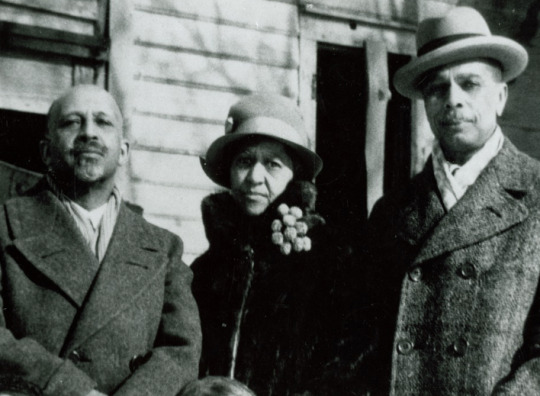
W.E.B. DuBois, Nina DuBois, James Weldon Johnson
The Harlem Renaissance (1917-1935) cannot be discussed without first paying homage to the work of two men who defined what creative art was to be in the years prior to the beginning of the Renaissance. Their work, in some cases groundbreaking, endures even now and laid the foundation for the extraordinary work that was to come during the Renaissance. Thanks to W.E.B. DuBois and James Weldon Johnson, there was a path towards mentorship, financial support and international recognition for what was to come that transformed the Black literary canon. Here is a comprehensive look at their works prior to the Renaissance.
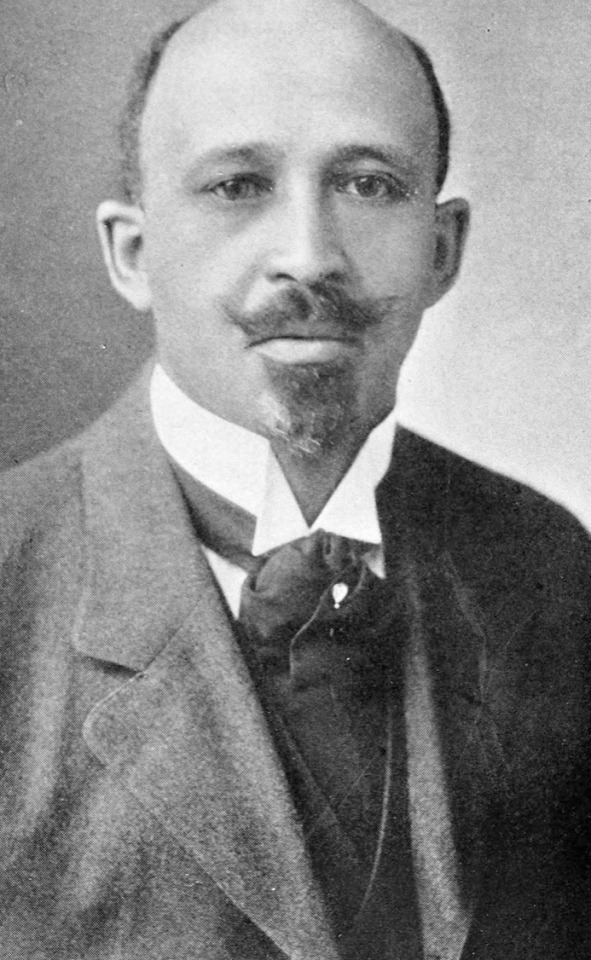
Dr. William Edward Burghardt DuBois (1868-1963)
"A black artist is first of all a black artist."
W.E.B. DuBois was a civil rights activist, historian, sociologist, author, writer, and editor. Becoming the first Black person in America to achieve a doctorate degree, he was educated at Fisk College, the University of Berlin, and Harvard. He became a sociology and economics professor at Atlanta University and was a founder of the Niagara Movement that eventually became known as the National Association for the Advancement of Colored People (NAACP). DuBois was considered the foremost Black sociologist and philosopher of the 20th century.

Keena and her son Jimmy at Clark Atlanta University at the bust of W.E.B. DuBois
Dr. DuBois published his seminal work of art, The Souls of Black Folk, in 1903 which was a collection of essays on Black life in America. The text covered very culturally specific topics such as his thoughts on Booker T. Washington’s “cast your buckets where you are” urging to Black people. In an 1895 speech at the Atlanta Exposition, Washington proposed that Black people reject leaving the South, essentially submit to segregation, and instead stay in order to learn a skill and eventually get an education; DuBois named this speech “The Atlanta Compromise” because he vehemently disagreed with the notion that Blacks should stay in the South and endure the unnecessary mistreatment of “separate but equal” and should instead pursue a liberal arts education. Also, another essay, “Of Our Spiritual Strivings”, discusses a term he coined called “the double consciousness”-- the idea that Black people must always be aware of their “two-ness”-- that they live in both a Black world with different norms and a white world governed by norms mired in white supremacy. In contemporary society, the terminology most closely associated with this idea of “two-ness” is “code-switching”. The Souls of Black Folk was by far a different type of text seen from Black people at the time and cemented his position as a premiere leader of the movement against racism. To read the text in its entirety, check-out the full texts on Audiobook or the e-book.
Also in 1903, he shared his major ideology that the Black race “would be saved by its exceptional men”. Deemed the “Talented Tenth” (read here), he explained that Black people who had attained wealth and/or an education needed to work hard to be the voices and leaders of any fight against racism as they themselves proved that many of the illogical ideas about Black people to be unfounded. He also believed it would be up to this emerging class of educated Blacks to reach into undereducated societies and raise up others. It was from this idea that he pushed the literary community of the Harlem Renaissance who were of the “Talented Tenth”.
In 1907, he published his sarcastic piece “On Being Crazy” (read here) which is a first hand account of a Black narrator’s encounters with white people in the South. Taking place in a variety of public spaces such as in the movies or at a restaurant, the text calls into question the illogical systems of racism that contemporary audiences can relate to in this day and age.
He then became the editor of the NAACP’s Crisis Magazine and employed Jessie Redmon Fauset to serve as its literary editor in which a vast majority of the writers of the Renaissance were featured. He used the Crisis to publish more of his essays and continued his creative output with novels and histories throughout the rest of the Renaissance. To learn more about W.E.B. DuBois, check out this interview with DuBois scholar Dr. David Levering Lewis here.
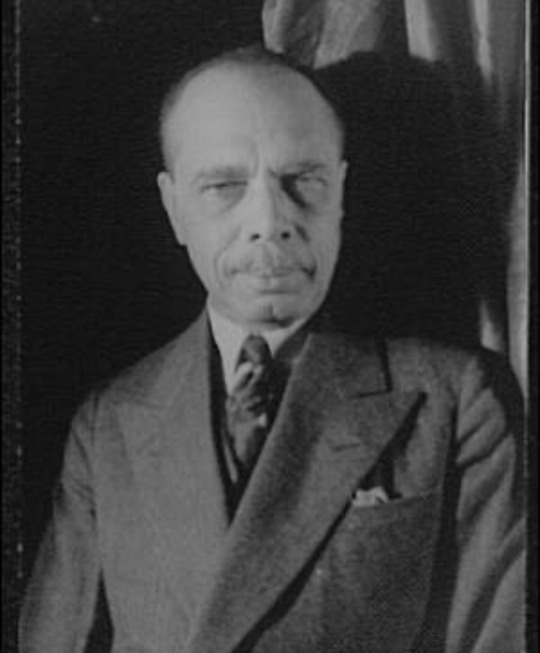
James Weldon Johnson (1871-1938)
James Weldon Johnson was a civil rights activist and writer. A graduate of Atlanta University, Johnson went on to become the NAACP’s first Executive Secretary, investigating many of the unfair cases of racism and brutality happening across the country. In 1912, he anonymously published The Autobiography of an Ex-Colored Man (a mostly fictional story about passing-- you can listen to the full text here) which he did not claim until 1927. During the Renaissance, he continued to produce collections of poetry including God’s Trombones and books of Black sermons. His sermons “Go Down Death“ and “The Creation“ are well-known and vastly performed texts that speak to the oratorical genius within the Black church.
In 1919, as NAACP Field Secretary, he had the unfortunate task of investigating lynchings and riots that were occurring-- naming it “The Red Summer” which is the name scholars use to describe that moment in history. Later that year, his poem “Lift Ev’ry Voice and Sing” (written in 1899) was named the official “Black National Anthem” which is still sung today before major events in the Black community.
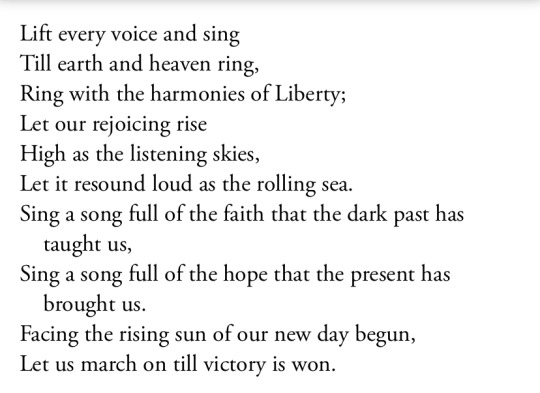
To learn more about James Weldon Johnson, watch this video.
Both men certainly set the stage for the creative output that came during the Renaissance, but also ushered in texts and ideologies that are enduring staples within the consciousness of Black Americans.
#HarlemRenaissance#w.e.b. du bois#Jamesweldonjohnson thesoulsofblackfolk liftevryvoiceandsing doubleconsiousness
2 notes
·
View notes
Photo

Zaya Wade Granted Name and Gender Affirmation by LA Court It’s official, Zaya Wade was granted an official name change and assignment of gender in a Los Angeles Court on Friday. Wade has gone by "Zaya" since 2020 after coming out as transgender. With the support of her father, former NBA player Dwyane Wade, and stepmother, Gabrielle Union, Wade has come into herself and popular culture, recently featuring in Puma’s ‘Forever.Classic’ campaign alongside Angus Cloud, Caleb McLaughlin and Iris Apatow. Related | Dwyane Wade Filed to Change Daughter's Legal Name and GenderUnion and her husband have become voices of LGBTQ+ allyship and were honored with the President’s Award at the 2023 NAACP Image Awards “in recognition of special achievement and distinguished public service.” The couple used their time to honor Wade and shine a light on the injustices facing LGBTQ+ youth today, with over 120 anti-trans bills introduced across the United States in 2023. “Black trans people are being targeted, terrorized, and hunted in this country every day, everywhere, and there’s rarely whisper about it,” Union said in an impassioned speech. “We honestly don’t approach this work as activists or leaders as much as we do this as parents,” she said. “Parents who love our children and will do whatever the hell we can to keep them seen and secure and safe.”Dwyane spoke directly to his daughter, sharing: “Zaya, as your father, all I’ve wanted to do was get it right. I’ve sat back and watched how gracefully you’ve taken on the public scrutiny. And even though it’s not easy, I watched you walk out of that house every morning as yourself. I admire how you’ve handled the ignorance in our world.” The road to legally affirming Wade's name and gender was no cakewalk since her father's filing in August 2022. In filing last November, Wade's biological mother, Siohvaughn Funches-Wade, alleged Dwyane was using their daughter's pursuit of name and gender affirmation to “profit.” The former basketball player responded to the allegations on Instagram, stating, "I've received a social media post about me forcing our 15 year old child to be someone she's not and to do something against her will. These are serious and harmful allegations that have hurt our children.” Related | Dwyane Wade Responds to Accusations That He's 'Pressuring' DaughterWith that behind her, Zaya Wade is embarking on her life and future as wholly herself. Photo courtesy of Jacopo Raule/GC Images https://www.papermag.com/zaya-wade-name-change-2659474341.html
0 notes
Photo
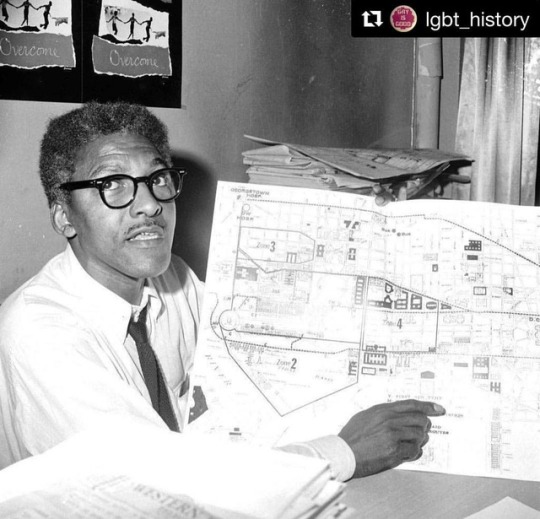
History Lesson 🌈 Repost @lgbt_history ・・・ "He was pushed aside. He was brilliant, but they thought it would hurt the movement—that certain senators would use it against the march. It was wrong. It was an affront to the man, to what he stood for, and to the contributions he made.” - Congressman John Lewis (@repjohnlewis) on Bayard Rustin and the 1963 March on Washington for Jobs and Freedom . Picture: Bayard Rustin plans for the March on Washington for Jobs and Freedom, 1963. Photo c/o New York Daily News. . In December 1962, trailblazers A. Philip Randolph and Bayard Rustin began planning a massive march on Washington to highlight the injustices faced by Black Americans. While the two men initially envisioned a radical convergence, by June 1963 they agreed to participate in negotiations with representatives from the most prominent civil rights organizations. This coalition, known as “The Big Six,” included Randolph, James Farmer (CORE), John Lewis (SNCC), Martin Luther King Jr. (SCLC), Roy Wilkins (NAACP), and Whitney Young (National Urban League). Rustin, an open homosexual who ultimately did most of the grassroots organizing for the March, was relegated to the role of deputy organizer after Wilkins and Young objected to his participation. . As the March approached, much of white America feared a revolt; 19,000 troops were readied, prisons prepared for mass arrests, alcohol sales were banned in the capital, and hospitals postponed elective surgeries. Until the last minute, opponents of the March sought to derail it: Senator Strom Thurmond went to the Senate floor to denounce Rustin, bomb threats grounded five planes headed for D.C., and the event’s massive sound system was sabotaged the day before the March (after much prodding, the U.S. Army Signal Corps rebuilt the system overnight). . And then, on August 28, 1963, fifty-five years ago today, with nearly 1,700 members of the press in attendance, the world watched 250,000 demonstrators participate in a massive peaceful demonstration that ended with Dr. King’s monumental “I Have a Dream” speech. . The March marked the beginning of a new era in the Civil Rights Movement and the Great March remains the standard https://www.instagram.com/p/BnCJPLNH8hI/?utm_source=ig_tumblr_share&igshid=1ky6v1t3r7cj
1 note
·
View note
Text
What Name Did The Democrats Give Southerners Who Became Republicans
Adams And The Revolution Of 1800
youtube
Shortly after Adams took office, he dispatched a group of envoys to seek peaceful relations with France, which had begun attacking American shipping after the ratification of the Jay Treaty. The failure of talks, and the French demand for bribes in what became known as the XYZ Affair, outraged the American public and led to the Quasi-War, an undeclared naval war between France and the United States. The Federalist-controlled Congress passed measures to expand the army and navy and also pushed through the Alien and Sedition Acts. The Alien and Sedition Acts restricted speech that was critical of the government, while also implementing stricter naturalization requirements. Numerous journalists and other individuals aligned with the Democratic-Republicans were prosecuted under the Sedition Act, sparking a backlash against the Federalists. Meanwhile, Jefferson and Madison drafted the Kentucky and Virginia Resolutions, which held that state legislatures could determine the constitutionality of federal laws.
Radio Coverage Of Presidents Johnsons Remarks Upon Signing The Civil Rights Act Of 1964: The Complete Speech
President Johnsonâs speech was delivered just two days before the 188th anniversary of the Declaration of Independence. In it the president cited the phrase âall men are created equalâ and pointed out that historically many Americans were denied equal treatment. The Civil Rights Act, he said, provides that âthose who are equal before God shall now all be equalâ in all aspects of American life. As President Johnson said, this was a long journey to freedom.
Courtesy of National Archives and Records Administration
Listen to the audio
Busiest Time Weve Had In Years
Imaging a florist busily responding with gratitude towards Congress, President Johnson, and Civil Rights leaders, Herblock captures sudden good will as the Senate voted for cloture to end fifty-four days of filibuster on the Civil Rights Act on June 10, 1954. The Senate finally passed the legislation on June 19, 1964. The Civil Rights Act was not the only item on President Johnsonâs legislative agendawhich led one reporter to call him âa âTexas Santa Clausâ in a ten-gallon hat.â
Herblock. âBusiest time weâve had in years,â 1964. Graphite and India ink drawing. Published in the Washington Post, June 12, 1964. Herbert L. Block Collection, , Library of Congress
Bookmark this item: //https://ift.tt/3yq7f8s
Senator Everett Dirksens Amendments To Title Vii
Senator Everett Dirksen , Republican from Illinois and Senate minority leader, comments on his amendments to Title VII, the employment section of the civil rights bill. The interview for The Great Divide: Civil Rights and the Bill, broadcast on ABC, May 22, 1964, was recorded earlier that week. After a compromise with Democratic Party leaders in the Senate, Dirksen was instrumental in persuading fellow Republicans to support the bill, and the filibuster that had held up passage ended.
Watch the video
Dixie’s Long Journey From Democratic Stronghold To Republican Redoubt
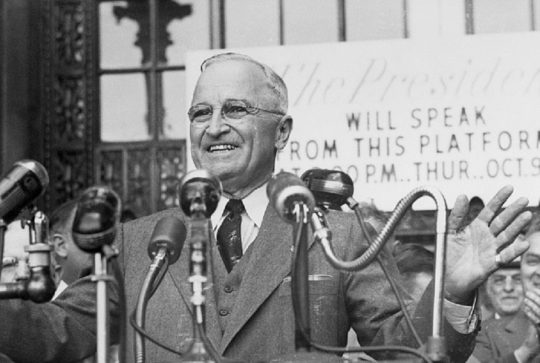
toggle caption
Ronald Reagan speaks to a reporter at the Republican National Convention in Florida in 1968. In 1984, Reagan carried in the biggest group of Southern Republicans in Congress since Reconstruction.
The tragic events in Charleston this month have released years of racial and political tension in the South, and the pressure is being felt by Republican officeholders across the region.
Why the Republicans? Because it is increasingly difficult to find officeholders in the region who are not Republicans.
The South was once home to the “yellow dog Democrat” who would vote for a mutt over someone from the party of Abraham Lincoln. Now, the party of the Great Emancipator has made Dixie its bedrock, the base of its Electoral College vote and its majorities in Congress. Many a great-granddaddy buried in rebel gray has been rolling over in his grave for some years now.
The South’s rejection of its Democratic DNA began more than 60 years ago with a Supreme Court decision, and significant historic milestones have followed like clockwork in almost every decade since.
The late Nelson Polsby, an influential and at times contrarian political scientist, wrote a book arguing that it was air conditioning that made the South competitive. It brought Republicans from other parts of the country into the South as retirees and as employers in growing numbers after World War II.
Here are a few of the major milestones in the migration of these Southern voters.
Clarence Mitchell Jr Calls For A Real Showdown On Civil Rights
As the 88th Congress began its second session early in January 1964, hearings on proposed civil rights legislation were about to commence in the House Rules Committee. Clarence Mitchell, Jr., , Washington Bureau director for the NAACP, explains the reason that the legislation has taken so long to reach this stage and calls for âa real showdown on civil rightsâ in this interview for At Issue: Countdown on Civil Rights, broadcast January 15, 1964, on National Educational Television.
Watch the video
Formal Debate Begins On The Civil Rights Bill
On March 30, the Senate began formal debate on H.R. 7152. Senator Richard Russell divided the senators opposing the bill, known as the Southern bloc, into three six-member platoons to prolong the filibuster. When one platoon had the floor, the other two rested and prepared to speak. Each member was responsible for talking four hours per day. Russell hoped the filibuster would erode public support for civil rights and compel the pro-civil rights senators to dilute H.R. 7152 in order to secure passage. He did not expect to defeat the bill.
Clarence Mitchell to Roy Wilkins, April 3, 1964 . Typed letter. NAACP Records, Manuscript Division, Library of Congress Courtesy of the NAACP
Bookmark this item: //https://ift.tt/3ksD4ZD
What Name Did The Democrats Give Southerners Who Became Republicans
Scalawags
Explanation: The term scalawag was given by Southern Democrats to fellow white Southerners who had become Republican and supported Reconstruction after the Civil War. They were considered traitors by many Southerners who remained loyal to the Confederate cause.
C. Scalawags
Explanation:
White southern Republicans, referred to their adversaries as “scalawags,” made up the greatest gathering of agents to the Radical Reconstruction-era legislatures. A few scalawags were established planters who felt that whites ought to perceive blacks’ considerate and political rights while as yet holding control of political and economic life.
Many were previous Whigs who saw the Republicans as the successors to their old party. Most of the scalawags were non-slaveholding small farmers as well as merchants, artisans and other experts who had stayed faithful to the Union amid the Civil War.
according to the report, the government has imposed restrictions on freedom of speech, freedom of the press, freedom of assembly, and freedom of association. the official media remained tightly controlled by government censorship and obstruction. restrictions on the freedom to assemble remain a problem in vietnam.
explanation:
Treatment Of Contempt Cases
youtube
On April 21, Senator Herman Talmadge called up his amendment requiring jury trials for all criminal contempt cases in the federal courts. It was withdrawn in favor of one by Senator Thruston Morton requiring a jury trial for any criminal contempt case arising from H.R. 7152. Civil rights advocates opposed the amendments because they doubted that Southern juries would convict white violators. Senator Everett Dirksen worked with Senator Mike Mansfield to offer a substitute amendment. It granted a judge the right to authorize a jury trial in all criminal contempt cases arising from the bill. If the accused was tried without a jury, the judge would be limited in the penalties he could impose to fines of up to $300 or sentences of up to thirty days.
Clarence Mitchell to Roy Wilkins, April 24, 1964 . Typed letter. NAACP Records, Manuscript Division, Library of Congress Courtesy of the NAACP
Bookmark this item: //https://ift.tt/3kqkktG
President Johnson Seeks Support Of Civil Rights Leaders
Immediately after signing the act, President Johnson held a meeting with civil rights leaders in the cabinet room at the White House. He wanted to ensure their collaboration, when the act would inevitably be tested, to not call for demonstrations and to carefully select test cases in the courts. In turn the president promised the full support of the Justice Department in protecting the act. He received assurances from those present that they understood and would cooperate.
Lee C. White. White House Memorandum, July 6, 1964. Courtesy of the Lyndon Baines Johnson Presidential Library and Museum, Austin, Texas
Bookmark this item: //https://ift.tt/3mFTkcb
It Took Much Longer And Went Much Further Than We Think
Most Americans have heard the story of the Southern strategy: The Republican Party, in the wake of the civil rights movement, decided to court Southern white voters by capitalizing on their racial fears. Republican presidential candidate Barry Goldwater first wielded this strategy in 1964 and Richard Nixon perfected it in 1968 and 1972, turning the solidly Democratic South into a bastion of Republicanism.
But this oversimplified version of the Southern strategy has a number of problems. It overstates how quickly party change occurred, limits the strategy solely to racial appeals, ignores how it evolved and distorts our understanding of politics today.
In reality, the South swung back and forth in presidential elections for four decades following 1964. Moreover, Republicans didnt win the South solely by capitalizing on white racial angst. That decision was but one in a series of decisions the party made not just on race but on feminism and religion as well. The GOP successfully fused ideas about the role of government in the economy, womens place in society, white evangelical Christianity and white racial grievance, in what became a long Southern strategy that extended well past the days of Goldwater and Nixon.
Over the course of 40 years, Republicans fine-tuned their pitch and won the allegiance of Southern whites by remaking their party in the Southern white image.
The End Of Radical Reconstruction
The end of Reconstruction was a staggered process, and the period of Republican control ended at different times in different states. With the Compromise of 1877, army intervention in the South ceased and Republican control collapsed in the last three state governments in the South. This was followed by a period that white Southerners labeled Redemption, during which white-dominated state legislatures enacted Jim Crow laws and, beginning in 1890, disenfranchised most blacks and many poor whites through a combination of constitutional amendments and electoral laws. The white Democrat Southerners memory of Reconstruction played a major role in imposing the system of white supremacy and second-class citizenship for blacks, known as The Age of Jim Crow.
Many of the ambitions of the Radical Republicans were, in the end, undermined and unfulfilled. Early Supreme Court rulings around the turn of the century upheld many of these new Southern constitutions and laws, and most blacks were prevented from voting in the South until the 1960s. Full federal enforcement of the Fourteenth and Fifteenth Amendments did not occur until passage of legislation in the mid-1960s as a result of the African-American Civil Rights Movement .
Republican Rule In The South

In the two years following the assassination of President Abraham Lincoln and the end of the Civil War in April 1865, Lincolns successor Andrew Johnson angered many northerners and Republican members of Congress with his conciliatory policies towards the defeated South. Freed African Americans had no role in politics, and the new southern legislatures even passed black codes restricting their freedom and forcing them into repressive labor situations, a development they strongly resisted. In the congressional elections of 1866, northern voters rejected Johnsons view of Reconstruction and handed a major victory to the so-called Radical Republicans, who now took control of Reconstruction.
Did you know? African Americans made up the overwhelming majority of southern Republican voters during Reconstruction. Beginning in 1867, they formed a coalition with carpetbaggers and scalawags to gain control of southern state legislatures for the Republican Party.
John Lindsay And Emanuel Celler On The Compromise Bill
On October 29, 1963, the House Judiciary Committee voted to report out a compromise civil rights bill to the full House. Representatives John Lindsay , Republican of New York, who helped craft the compromise bill after a stronger bill had been attacked by the Kennedy Administration and others as having no chance of passing, and Emanuel Celler , Democrat of New York and chairman of the committee, discuss the two bills in this excerpt from At Issue: Countdown on Civil Rights, broadcast January 15, 1964, on National Educational Television.
Watch the video
Georgia Democrats Typically Did Not Like Fellow Southerners Who Became Republicans After The Civil War And Supported Reconstruction Of The South
What name did the Democrats give Southerners who became Republicans?Abolitionists Carpetbaggers Scalawags Freedmen
Answer
answer is carpetbaggers remember it like a carpet goes up and the south came up in reconstruct with the north some of them
Virtual Teaching Assistant: Colleen R.
Question Level: Basic
Letter From Jane Horn
In 1964, Jane Horn worked for the Protestant Council of the City of New York. She organized 1,000 church and labor union members on a trip to Washington, D.C., to march in support of the Civil Rights Act. Horn also participated in the silent vigil in support of the act. Beginning in April of 1964, Catholic, Jewish, and Protestant seminary students served in shifts at the Lincoln Memorial, silently praying night and day until the act was passed by the Senate on June 19.
Jane Horn to the Voices of Civil Rights Project, June 5, 2004. Letter. Voices of Civil Rights Project Collection, American Folklife Center, Library of Congress Courtesy of Jane Horn
Bookmark this item: //https://ift.tt/3Bf2i4c
How Did This Switch Happen
youtube
Eric Rauchway, professor of American history at the University of California, Davis, pins the transition to the turn of the 20th century, when a highly influential Democrat named William Jennings Bryan blurred party lines by emphasizing the government’s role in ensuring social justice through expansions of federal power traditionally, a Republican stance.
But Republicans didn’t immediately adopt the opposite position of favoring limited government.
Related: 7 great congressional dramas
“Instead, for a couple of decades, both parties are promising an augmented federal government devoted in various ways to the cause of social justice,” Rauchway wrote in an archived 2010 blog post for the Chronicles of Higher Education. Only gradually did Republican rhetoric drift to the counterarguments. The party’s small-government platform cemented in the 1930s with its heated opposition to the New Deal.
But why did Bryan and other turn-of-the-century Democrats start advocating for big government?
According to Rauchway, they, like Republicans, were trying to win the West. The admission of new western states to the union in the post-Civil War era created a new voting bloc, and both parties were vying for its attention.
Related: Busted: 6 Civil War myths
Additional resources:
Passage Of Civil Rights Bill Final Vote
Artist Howard Brodie captures the hustle and bustle of the Senate floor, the sense of people in the packed gallery pressing to see everything below, and the pages rushing to the edge of the dais on June 19, 1964, when the Senate voted to pass the Civil Rights Act of 1964. On July 2, 1964, President Lyndon Baines Johnson signed the bill into law. Brodie, a courtroom artist, covered the debates for CBS News.
1 of 2
Howard Brodie. Senate before final Civil Rights vote, final day. Crayon drawing, 1964.Howard Brodie Collection, , Library of Congress © Estate of Howard Brodie
Bookmark this item: //https://ift.tt/3Bf2iBe
âIn a jammed chamber of the U.S. Senate there came the solemn moment on Friday, June 19, when the eleven title Civil Rights Bill was approved by a vote of 73 to 27.â
Clarence Mitchell to Roy Wilkins, June 20, 1964
Barry Bonds Hits 715th Home Run To Pass Babe Ruth On Mlb List
Congress passage of the Reconstruction Acts of 1867 marked the beginning of the Radical Reconstruction period, which would last for the next decade. That legislation divided the South into five military districts and outlined how new state governments based on universal suffragefor both whites and blackswere to be organized. The new state legislatures formed in 1867-69 reflected the revolutionary changes brought about by the Civil War and emancipation: For the first time, blacks and whites stood together in political life. In general, the southern state governments formed during this period of Reconstruction represented a coalition of African Americans, recently arrived northern whites and southern white Republicans .
Civil Rights Legislation On The Fast Track
Senator Wayne Morse sails into the air after his motion to send the proposed Civil Rights legislation to the Judiciary Committee was defeated on March 26, 1964. Conservative cartoonist Gib Crockett, chief cartoonist at the Washington Star, appropriately uses a high-speed train as the metaphor for the Civil Rights legislation. After Morseâs motion was defeated, the Senate moved forward to debate it, driven by Minnesota Senator Hubert Humphrey, because President Lyndon Baines Johnson had put it on the fast track.
Gib Crockett. The switchman knew when he felt the bump, that the man at the throttle was Hubert Hump! 1964. Ink brush, crayon, and opaque white drawing. Published in the Washington Star, March 30, 1964. Art Wood Collection of Cartoon and Caricature, , Library of Congress
Bookmark this item: //https://ift.tt/3kvVnwP
Democrats V Republicans On Jim Crow
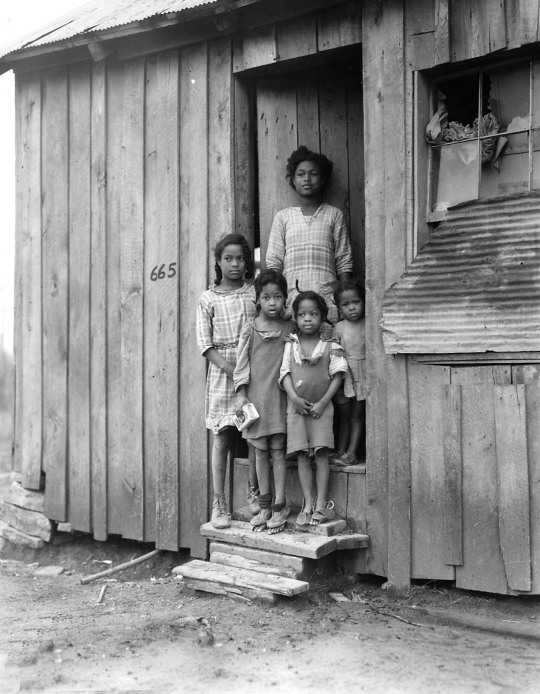
Segregation and Jim Crow lasted for 100 years after the end of the Civil War.
During this time, African Americans were largely disenfranchised. There was no African-American voting bloc. Neither party pursued civil rights policies it wasnt worth their while.
Democrats dominated Southern politics throughout the Jim Crow Era. Its fair to say that Democratic governors and legislatures are responsible for creating and upholding white supremacist policies.
Southern Democrats were truly awful.
Iv Reconstruction And Women
Susan B. Anthony and Elizabeth Cady Stanton maintained a strong and productive relationship for nearly half a century as they sought to secure political rights for women. While the fight for womens rights stalled during the war, it sprung back to life as Anthony, Stanton, and others formed the American Equal Rights Association. , between 1880 and 1902. Library of Congress.
for all
The AERA was split over whether Black male suffrage should take precedence over universal suffrage, given the political climate of the South. Some worried that political support for freedmen would be undermined by the pursuit of womens suffrage. For example, AERA member Frederick Douglass insisted that the ballot was literally a question of life and death for southern Black men, but not for women. Some African American women challenged white suffragists in other ways. Frances Harper, for example, a freeborn Black woman living in Ohio, urged them to consider their own privilege as white and middle class. Universal suffrage, she argued, would not so clearly address the complex difficulties posed by racial, economic, and gender inequality.
Senate Civil Rights Debate
Working for CBS as a courtroom illustrator, Howard Brodie captured not only the action on the Senate floor, but the sensibility of the crowd in the gallery above. Blacks, whites, the elderly, the young, men and women gathered together, united in their desire to see the creation of the historic legislation.
Howard Brodie. Senate Civil Rights debate, Gallery. Crayon drawing, 1964. Howard Brodie Collection, , Library of Congress © Estate of Howard Brodie
Bookmark this item: //https://ift.tt/3BoAgDL
âIt is expected that the Mansfield-Dirksen amendment will be approved by a substantial vote.â
Clarence Mitchell to Roy Wilkins, May 8, 1964
Lawyer Clifford Alexander Interviewed By Camille O Cosby In 2006
Lawyer Clifford Alexander, Jr., , chairman of the U.S. Equal Emplyment Opportunity Commission , explains the meaning of the Civil Rights Act and how both blacks and whites in government pushed for change in an interview conducted by Camille O. Cosby for the National Visionary Leadership Project in 2006.
Watch the video
Civil Rights Activist Gwendolyn Simmons Interviewed By Joseph Mosnier In 2011
youtube
Civil rights activist Gwendolyn Simmons discusses Freedom Summer and her shock that Goodman, Chaney and Schwerner were murdered in an interview conducted by Joseph Mosnier for the Civil Rights History Project in 2011.
Civil Rights History Project Collection , American Folklife Center
Watch the video
Republicans And Democrats After The Civil War
Its true that many of the first Ku Klux Klan members were Democrats. Its also true that the early Democratic Party opposed civil rights. But theres more to it.
The Civil War-era GOP wasnt that into civil rights. They were more interested in punishing the South for seceding, and monopolizing the new black vote.
In any event, by the 1890s, Republicans had begun to distance themselves from civil rights.
The Myth Of The Republican
When faced with the sobering reality that Democrats supported slavery, started the Civil War when the abolitionist Republican Party won the Presidency, established the Ku Klux Klan to brutalize newly freed slaves and keep them from voting, opposed the Civil Rights Movement, modern-day liberals reflexively perpetuate rather pernicious myth–that the racist southern Democrats of the 1950s and 1960s became Republicans, leading to the so-called “switch” of the parties.
This is as ridiculous as it is easily debunked.
The Republican Party, of course, was founded in 1848 with the abolition of slavery as its core mission. Almost immediately after its second presidential candidate, Abraham Lincoln, won the 1860 election, Democrat-controlled southern states seceded on the assumption that Lincoln would destroy their slave-based economies.
Once the Civil War ended, the newly freed slaves as expected flocked to the Republican Party, but Democrat control of the South from Reconstruction until the Civil Rights Era was near total. In 1960, Democrats held every Senate seat south of the Mason-Dixon line. In the 13 states that made up the Confederacy a century earlier, Democrats held a staggering 117-8 advantage in the House of Representatives. The Democratic Party was so strong in the south that those 117 House members made up a full 41% of Democrats’ 283-153 advantage in the Chamber.
So how did this myth of a sudden “switch” get started?
It would not be the last time they used it.
The Importance Of Quorums
In this memorandum Arnold Aronson explains the importance of quorums. Under Senate rules each senator could deliver only two speeches on the same subject in a legislative day. Two senators could sustain a filibuster for eight hours by demanding frequent quorum calls that required fifty-one opposing senators to answer a roll call. If the opponents failed to produce a quorum, the Senate had to adjourn. The next day the filibustering senators could begin a new round of speeches. Senator Humphrey and Senator Thomas Kuchel addressed the quorum problem by dividing their troops into platoons and setting up a duty roster. Humphrey was committed to producing a daily quota of thirty-six Democratic senators for quorums; Kuchel pledged fifteen Republicans.
Arnold Aronson, secretary, Leadership Conference on Civil Rights to Cooperating Organizations regarding senators who support the civil rights bill, , March 16, 1964. Memorandum. Page 2 – Page 3 – Page 4 – Page 5 Leadership Conference on Civil Rights Records, Manuscript Division, Library of Congress
Bookmark this item: //https://ift.tt/3yoyBvX
âWe have a great team of senators led by Senators Hubert Humphrey . . . and Thomas Kuchel . . . .â
Clarence Mitchell to Roy Wilkins, March 27, 1964
âThe Civil Rights Bill is now the pending business in the Senate. The fight is on. We will need every vote that we can get.â
Clarence Mitchell to Roy Wilkins, March 27, 1964
Charles Sumner And Thaddeus Stevens

Charles Sumner: Charles Sumner was an American politician and senator from Massachusetts. During Reconstruction, he fought to minimize the power of the ex-Confederates and to guarantee equal rights to the freedmen.
Concerned that President Johnson was attempting to subvert congressional authority, Republicans in Congress took control of Reconstruction policies after the election of 1866. Radical Republicans, led by Charles Sumner and Thaddeus Stevens, opened the way to suffrage for male freedmen. As the chief Radical leader in the Senate during Reconstruction, Sumner fought hard to provide equal civil and voting rights for the freedmen on the grounds that consent of the governed was a basic principle of American republicanism, and to block ex-Confederates from power so they would not reverse the gains made from the Unions victory in the Civil War.
Sumner, teaming with House leader Thaddeus Stevens, battled Andrew Johnson s Reconstruction plans and sought to impose a Radical program on the South. The Radical Republicans were generally in control of policy, although they had to compromise with the moderate Republicans. The Democrats in Congress had almost no power. Historians generally refer to this period as Radical Reconstruction.
source https://www.patriotsnet.com/what-name-did-the-democrats-give-southerners-who-became-republicans/
0 notes
Link
Naomi Levine, Lawyer Who Transformed a University, Dies at 97 Naomi Levine, who as executive director of the American Jewish Congress in the 1970s was the first woman to lead a major Jewish advocacy organization, and who later became an instrumental force in New York University’s transformative expansion into a top-tier institution, died on Jan. 14 at her home in West Palm Beach, Fla. She was 97. The death was confirmed by her daughter, Joan Kiddon. Ms. Levine, who grew up in the Bronx in the 1930s, first aspired to become a public-school teacher. But, as she told it, she was rejected after taking an oral exam because she had a lisp and decided to pursue law instead. She attended Columbia Law School, where among the other students in the 1940s were such soon-to-be-prominent women as the pioneering feminist politician Bella Abzug, the labor lawyer Judith Vladeck and the federal judge Constance Baker Motley. In the 1950s, Ms. Levine joined the American Jewish Congress as a lawyer on its Commission on Law and Social Action. There, often in partnership with the NAACP Legal Defense Fund, she wrote briefs in decisive Supreme Court cases, including Brown v. Board of Education, which dismantled segregation in public schools, and Sweatt v. Painter, which successfully challenged the “separate but equal” doctrine established by Plessy v. Ferguson. In 1963 Ms. Levine helped Rabbi Joachim Prinz write “The Issue is Silence,” a speech expressing solidarity with the civil rights movement, which he delivered moments before the Rev. Dr. Martin Luther King Jr. gave his famous “I Have a Dream” speech at the March on Washington. She later taught a class at the John Jay College of Criminal Justice on law and race relations in policing. As she pursued her law career, Ms. Levine often found herself surrounded by men. “I knew I deserved to be there because I was as smart as, and often smarter than, everyone else in the room,” she once said. “And if I kept my mouth shut about it, I could get an awful lot done.” In 1972, Ms. Levine was appointed executive director of the American Jewish Congress, a position that brought her visibility and influence. In an interview with The New York Times that year, she reflected on the women’s movement and the balance of responsibilities between spouses. “I still feel somewhat guilty when I spend too much time away from home, and if my daughter got sick I would stay home and care for her — I wouldn’t expect my husband to,” she said. “The young girls today think differently, and they’re right.” She summed up her view this way: “Women’s lib is probably correct, but it’s not my style.” In 1978, Ms. Levine left the American Jewish Congress and, eager for a new challenge, accepted a position at N.Y.U. She was tasked with helping the troubled institution realize its ambitions of becoming a top-tier university. At the time, N.Y.U. wasn’t the prestigious academic institution it is today. It had a meager endowment and, with its crumbling campus buildings and drab dormitories, was struggling to attract students. Ms. Levine began leading the university’s charge toward change as its chief fund-raiser, and she quickly proved to be gifted at the strategic art of raising money. Over the course of two decades, she raised more than $2 billion; toward the end of her tenure, she was raising around $300 million per year. In 1985, she launched an unprecedented $1 billion fund-raising campaign, which earned her some skepticism, but when the feat was accomplished a decade later, the initiative was celebrated as one the most ambitious such efforts in higher education. By the beginning of the 21st century, N.Y.U. had reinvented itself, and its expansion continued to accelerate through Lower Manhattan. The headline of a 2001 article in The New York Times called Ms. Levine, who was then a senior vice president, the “Dynamo at the Heart of N.Y.U.’s Fund-Raising”; the article noted that the expression “Clear it with Naomi” had become commonplace within the university’s administration. “It is impossible to overstate Naomi’s contribution to the transformation of N.Y.U.,” John Sexton, the university’s president from 2002 to 2015, said in a phone interview. “Anyone who knows the generative forces that took N.Y.U. from its nadir, which is at the advent of her arrival, to where it was in 2000 and beyond, knows that she was one of the key generators of those forces.” After stepping down as the university’s chief fund-raiser, Ms. Levine established the George H. Heyman Jr. Center for Philanthropy and Fundraising at N.Y.U., where she also taught a graduate course called “Ethics, the Law and Board Governance in Nonprofit Organizations.” She retired in 2004. Ms. Levine’s commitment to social issues remained a through line in her career, expressed perhaps most personally at Camp Greylock, the all-girls summer camp in the Adirondacks that she ran from 1955 to 1971. A mail boat would deliver copies of The New York Times to the camp, and Ms. Levine moderated discussions about current events with campers in a dining hall. She reluctantly closed the camp to focus on her work at the American Jewish Congress. Many campers, who still pridefully call themselves “Greylock Girls,” grew up to become leaders in law, business and medicine. “Regardless of age, she wanted these girls to know you can do anything and be anything,” Ms. Kiddon, her daughter, said. “She believed she could empower these girls for life.” Naomi Ruth Bronheim was born on April 15, 1923, in the Bronx. Her father, Nathan, was a salesman. Her mother, Malvina (Mermelstein) Bronheim, was a hospital secretary. When Naomi was a girl, she helped prepare a pot of flanken cholent stew on Friday nights in preparation for the Sabbath, and her mother sewed clothes for the family. Naomi attended Hunter College High School and graduated from Hunter College with a B.A. before enrolling at Columbia Law School, where she became an editor of the Law Review. In 1948 she married Leonard Levine, an accountant who had fought in the third wave at Normandy; he died in 2001. In addition to her daughter, Ms. Levine is survived by two granddaughters and a great-granddaughter. After Ms. Levine retired, N.Y.U. recognized her with a Presidential Medal in 2005. She remained on the board of the school’s Edgar M. Bronfman Center for Jewish Student Life and also advised the Taub Center for Israel Studies. A few years ago, Ms. Levine moved to West Palm Beach, where she began writing a memoir tentatively called “History and Me.” She also started a book and film club at the Kravis Center (which her daughter described as “the Lincoln Center for West Palm Beach”) where members discussed social issues. After watching “To Kill a Mockingbird” (1962), they talked about racism in America; after “Adam’s Rib” (1942), they shared their views on sexism and gender inequality. Ms. Levine hoped to one day show the 1933 film version of “Little Women.” In 2016 she told The Palm Beach Daily News that Katharine Hepburn’s headstrong portrayal of the main character, Jo March, had inspired her when she saw the movie as a girl. “She wanted to free herself from being an ordinary woman,” Ms. Levine said. “That influenced my thinking.” Source link Orbem News #Dies #Lawyer #Levine #Naomi #transformed #university
0 notes
Text
Marshall
I had the chance to see Marshall today. It is the film in which Chadwick Boseman plays Thurgood Marshall, another one of my heroes.
I was pleased to discover several "Black Panther" connections. Sterling K. Brown (our mystery Wakandan) plays Joseph Spell, the innocent man accused of raping a white woman.
And the film was directed by Reginald Hudlin, co-creator of my girl Princess Shuri, who wrote the wonderful "Who Is Black Panther?" arc of the comics which later became the basis for the BET cartoon.
It would be cool if Hudlin got a crack at directing a Marvel movie. A Shuri movie maybe?
I had some reservations about seeing this film, as I had read that the role of the white Jewish lawyer (played by Josh Gad) was made much more dramatic than the history warrants and also bigger to appeal to white audiences.
(I tend to think white people should just watch stuff about other races the way everyone else has to, and we should stop babying racists.)
Review below the cut as it is not Black Panther related.
I think Boseman is great, of course. It’s unfortunate that Marshall is not a character that gets to have an arc. He goes from one place to another doing the same thing (arguing cases for the NAACP). He comes in a gives inspirational speeches to Gad, who is fine, I guess. But he is above it all, in an odd way.
I think it is really Sterling K. Brown (who doesn’t have THAT many scenes) who shines in the bits he is in. He’s a man who is facing one of the scariest situations--a black man accused of raping a white woman. His fear is palpable.
I would like to propose that Boseman reprise the Marshall role throughout his career. There is a great book "Devil in the Grove" that I would watch as a feature. And then his time as a Supreme Court Justice? There is a lot here!
12 notes
·
View notes
Text
5 activists on how they’re carrying Rep. John Lewis’s legacy forward
5 activists on how they’re carrying Rep. John Lewis’s legacy forward
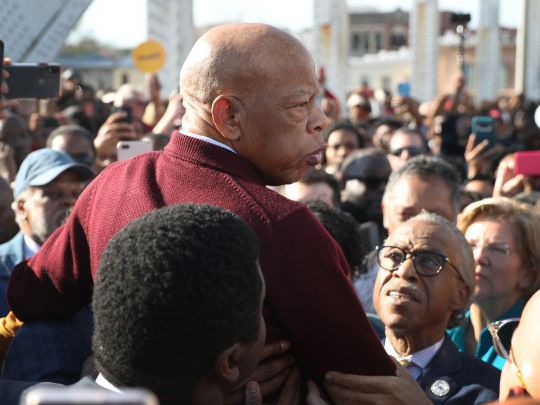
Rep. John Lewis amid supporters at the Edmund Pettus Bridge in Selma, Alabama, in March 2020. | Joe Raedle/Getty Images
Lewis often encouraged other activists to make “good trouble” — these 5 reflect on continuing to do just that.
Rep. John Lewis, a Georgia congressman and icon of the civil rights movement, died Friday at the age of 80.
Throughout his decades-long career, Lewis was known for his activism — from his roots as a Freedom Rider and firebrand organizer of the March on Washington, to the many times he was arrested, some as a member of the US House of Representatives. In his time as a lawmaker, he became an advocate for LGBTQ rights, expanded freedoms for immigrants and refugees, and supported gun reform measures. He continued this work in his final weeks — just a month before he died of pancreatic cancer, he visited Washington, DC’s Black Lives Matter Plaza, one of many places reflecting the current wave of anti-racism protests sweeping the world.
He was known for encouraging people to become activists themselves, saying they should not hesitate to get in “good trouble.” And he inspired many to do just that.
Here, five activists reflect on what Lewis’s legacy meant to them, and how it may be carried forward. Their responses, edited for clarity and length, are below.
Tanya Washington, professor of law at Georgia State University and former director of the John Lewis Fellowship Program
At 21, he was one of the first Freedom Riders; at 23, he was the chairperson of SNCC, and helped organize the March on Washington, and at 25, he was at the Selma protests. I think it’s empowering for young people to recognize that their energy, their perspective is necessary. It’s young people who moved the needle in the civil rights movement. They were college students, high school students. Some were even younger than that — the kids who integrated schools after Brown v. Board were little school kids. I think younger activists will draw from his legacy a sense of power and responsibility: Their contribution can begin right now.
Everyone quotes him saying, “Get in good trouble.” I think what that really has meant to me is to not be afraid to make decisions that are unpopular. What other people might call trouble, through a historical lens will be called progress. It’s inspired me to take risks when I’m guided by my moral compass.
I definitely see [his influence] when I look at the Black Lives Matter movement, and I see the young people in the streets, risking their lives and their health to enforce democracy, to make sure that we have justice as part of our criminal legal system, and that we eradicate racism. I see the same spirit that motivated John Lewis as a young person to get involved. He decides while he’s in college to sign up to be a Freedom Rider, which is not going to end well, just in terms of the risk to life and limb that it entails. But it was something he was willing to die for. And I’m seeing that same commitment made by young people who have been protesting in opposition to the issues, racism, and xenophobia that are all too prevalent in society today. I see that same spirit of youth activism, and that dedication and commitment.
One of the things that I really loved about John Lewis is that he understood that equality is not divisible. He wasn’t just fighting for equality and just for Black people, but for everyone. Unless everyone can enjoy equality, equality doesn’t exist. … I hope we will continue to see people working across intersectionality. It’s not just Black people, it’s trans Black women, it’s poor Indigenous men, it’s people from the LGBTQ community. All across the spectrum, until all of us are treated equally, none of us are treated equally. When he talked about the “beloved community,” he meant everybody.
He lived a life that set the example for how human beings can have an impact. From very humble beginnings, he became an American hero. I am so honored and humbled to have had a chance to work with him and to be inspired by his legacy. And I’ll miss him.
Janai Nelson, associate director-counsel of the NAACP Legal Defense and Educational Fund (LDF)
[Lewis] really underscored for me the power and the strength that it takes to do civil rights [work], and really crystallized the role of Black people in shaping this nation on an ongoing basis, and forcing this country to live up to its ideals and to deliver on its promises. It is truly by force that it happens — it’s by the force of will and stamina and strategy, on the part of people who have largely been nonviolent.
There’s a strength and power in that that is just immeasurable, and he embodied that completely. He was the epitome of that strength and power that could move mountains and destroy systems and force political hands, just through his tenacity and resolve and strategy. And brilliance — he was absolutely brilliant.
When I look at the faces of protesters on the street today, I see John Lewis. I see the Freedom Riders. … When I see young people going up against police, in military gear, who will wantonly attack them, even though they are only exercising their constitutional right of freedom of assembly and freedom of speech, I see the bravery of people like John Lewis all over again. He set an example of what it means to speak truth to power, to look evil in the face and not blink.
One [way to carry forward his legacy] is to continue the unfinished business of building this democracy by securing and protecting the right to vote on an equal basis for all people, and that requires the passage of the Voting Rights Advancement Act, which would restore the legislation that he put his life on the line for (the Voting Rights Act of 1965), and protect the right to vote during a period of history when it is under severe and pernicious attack.
And the other policy area is the protection of protesters: Ensuring that the methodology that he used to great success is one that continues to be among the tools and the arsenal of people who want transformative change. If we cannot protect protesters — if we allow law enforcement and white supremacists to attack and interfere with peaceful protest — then we haven’t learned anything from the history of people like John Lewis.
It’s just remarkable to me how loving and upbeat and kind he remained, even toward his worst enemies. … Every American owes a debt to John Lewis for his sacrifice and his lifetime of service. He never seemed embittered by the fact that, even at 80, he still had to struggle for the rights that he fought for 55 years ago. He didn’t throw up his hands. He just encouraged others to keep up the fight, and stood right there with them and helped to lead it.
To face those struggles, to still be so generous of spirit and optimistic, it’s remarkable, and it’s the true marker of a whole person, of someone who is so self-possessed and is too strong to have their character marred by the external frailties of this country.
Kamau Chege, manager of the Washington Census Alliance
In 2013, I graduated high school, and shortly afterward, [worked as] an affiliate leader [with] United We Dream. That summer was the big summer for pushing the comprehensive immigration reform bill. We did a whole bunch of actions, but near the fall, as we’re wanting to escalate, members of Congress were demonstrating outside the Capitol, and Rep. John Lewis was arrested.
A couple weeks before that, I had gone down to DC, and we were strategizing how people were going to push [for the bill]. I went to talk to the Congressional Black Caucus, and was able to catch Rep. Lewis as he was walking. He was a fast walker! He was running late to a vote. I was explaining the bill, and asked, “Can we count on you?” He said, “You can count on me,” and gave the thumbs up.
I was young in 2013 — I was 18 years old — and this was somebody who was in our history and AP Gov classes, with the PBS Eyes on the Prize series. This is how the younger millennials understood him.
It wasn’t ’til the action where he was arrested, and I was watching that ... from afar, [where I] got this sense of, ‘This is his life’s work, in some ways: getting arrested for racial justice.’ He’s been doing this since he was my age; he joined SNCC when he was young.
I'm not the first to make this observation, but it's remarkable that for decades we had a sitting member of congress from the civil rights movement who regularly encouraged the public to break laws for the cause of racial justice. 10 days ago today: https://t.co/C5yT9pdH9O RIP. https://t.co/nKCjq1kKhg
— ☂️Kamau (@Kamaumaumau) July 18, 2020
After news came down that he had passed, one of the things I was thinking about, and I’ve been thinking about the past few years — my family has been here for 20 years, and we’ve been undocumented for 17 — is what kind of country my parents thought they were immigrating to.
They were probably trying to come to a country where everyone was guaranteed a dignified life. Jobs and justice. That’s a country that John Lewis probably did not see when he was young ... but it’s one that he got to see the beginnings of by the time I met him, in 2013, in the House, pushing for and alongside the new currents of movements.
[In 2013,] we’d be training for civil disobedience. Part of that would include reading about SNCC, what did they do, what kind of actions did they use, how were they able to push things forward and build a movement that a lot of people could see themselves in.
You run into a lot of John Lewis’s work, and how he ran SNCC at the time, and that’s still common. There’s still people from SNCC that advise young organizers now. And that meant that we saw ourselves as not starting something new, but in a lineage and a tradition of young people in general, and young Black and brown organizers, protesting and pushing to make sure that we grow up in the kind of country that John Lewis, C.T. Vivian, and the rest were shaping.
LaTosha Brown, co-founder of Black Voters Matter Fund
He deeply believed in democracy. There were American founders who believed in creating this new nation, and they had some ideas, and explored a philosophy with democracy, but their actions show that they didn’t believe in the fullness of American democracy. They were the founders of the country, but not of democracy. They didn’t have the foresight to see John Lewis as a member of Congress, or to even see him as human enough to be able to vote.
John Lewis is one of the forefathers in this country of true democracy, who really internalized and believed in the expansion of the vote, not just for Black people but for all citizens. He believed in equality for all people. The forefathers didn’t believe that. He believed that.
I think he had an acute awareness of the work of young people, and of when young people are [being] marginalized in the movement. He provided a lot of grace and space for young people, which is why one of the last things he did was go out to [Washington, DC’s] Black Lives Matter Plaza. That was a message of, ‘I’m in solidarity with you.’ He was able to bridge this political world and this activist world, and understand the evolution of how movements take place.
The last time I saw him was this year in the Selma-Montgomery march [at the Edmund Pettus Bridge]. I didn’t think he was going to come this year, because of his cancer. … As we get to the top of the bridge, I’m standing there, the crowd stops. … He walks up to the crowd, like Moses parting the sea. I’m directly in front of him. I knew that was his last speech. I don’t know how I knew, but I knew.
“We were beaten, we were tear gassed. I thought I was going to die on this bridge. But somehow and someway, God Almighty helped me here.” This would be the last time John Lewis would visit the Edmund Pettus Bridge, 55 years after Bloody Sunday pic.twitter.com/BXqHyO0CQl
— philip lewis (@Phil_Lewis_) July 18, 2020
As an activist, the weeks prior to that had been really tough. … I was really feeling overwhelmed. I’m looking at this man who is literally battling cancer, to actually have the courage, to actually get the strength, and you could tell he was weak. He speaks to us, and it was just what I needed to feel affirmed. Even in that moment, I knew that I couldn’t ever stop this work. There’s a song, “Sweet Honey in the Rock:” “We who believe in freedom cannot rest until it comes.”
Here’s this 80-year-old man who is in Congress, who could literally just go sit at home and do what he wants and just be loved. He knew the importance of that moment, but he also knew the importance of that work. I felt that I, along with millions of others, were knighted. I felt affirmed and knighted in that moment, that our work was necessary.
I think it is not good enough to go back to the place from which we came. We are in a relay. We’ve got to take it forward. There’s a fragility [to] American democracy. … When you ever have your citizens in a place where they can fully participate, fully engage, that’s where you build patriotism. You don’t build patriotism by forcing people to acknowledge a flag that has been a symbol of hatred and racism. You build patriotism by creating the space for American citizens to engage, to be affirmed, and demonstrate their God-given agency.
Raquel Willis, director of communications of Ms. Foundation for Women; founder of Black Trans Circles
I met the congressman in 2016. He met with a group of organizers in Atlanta who were part of the Black Lives Matter movement. It was a powerful experience. He talked about his experiences and really gave us encouragement around the activism and the organizing work that we were already doing.
His lifelong commitment to liberation work is inspiring, I think particularly at the beginning of his organizing career. It’s important to understand that, no matter what age you are, you can get into the fight, and this is really, like it was for him, a lifelong commitment. So, we can’t expect there to be quick, flash-in-the-pan fixes for these systems of oppression. We have to be invested in the future.
Congressman John Lewis will forever be an example of a lifelong commitment to liberation. I will never forget the time he took to share his insights and encouragement with Atlanta #BlackLivesMatter organizers in 2016. His contributions are simply innumerable. #RIP, Sir. pic.twitter.com/7R7mXSGgtb
— Raquel Willis (@RaquelWillis_) July 18, 2020
The movement that is happening now is just the continuation of Black liberation work that has happened for centuries. We like to have this idea that these movements are completely separate, but really, a lot of what has fueled [activists today] has come from the movements before. There’s a direct line to the civil rights movement from where we are now in the movement for Black lives.
Particularly in this election year, I think his work around strengthening folks’ access to electoral power is important, but I also think that sometimes what’s more important is the organizing that happens on the ground amongst the people, just getting people involved, beyond voting. There’s so many different ways that people can transform society, and I think we often only, or mostly, focus on electoral power.
When it comes to organizing, you can organize around so many different things, that what’s important is stretching the muscle. I think of organizing as a creative endeavor, so we have to be thinking about ways that we can expand access in whatever instances or spaces that we’re in.
I think it’s important when any figure dies that we hold the honor that we have for them, but that we hold the hard critiques that we may have about their decisions or some of their rhetoric while they were here. We do a disservice in trying to paint anyone as perfect. I think we can hold complicated feelings about figures without throwing out their legacy.
We should certainly be grateful for the strides that a figure like the congressman made, and we can also think about the ways that we can hold those critiques, honor those critiques and make a commitment to grow in our own work and be better figures for generations to come. I think a lot of what we can learn from any figure’s life is there’s so much more work to do, and there’s so many more ways to open doors for generations to come.
I hope that folks will continue to be invested in the organizers who are doing work on the ground today. We have a society that loves to look at our history of organizing with rose-colored glasses. Folks talk about the “civil rights movement” now, but at the time [those activists] were very maligned, and there wasn’t a genuine support for the work that they were doing, and that still continues today. I think we have to be reflective on the ways that we may critique current movements without really engaging with what they’re saying or what they’re fighting for.
Support Vox’s explanatory journalism
Every day at Vox, we aim to answer your most important questions and provide you, and our audience around the world, with information that has the power to save lives. Our mission has never been more vital than it is in this moment: to empower you through understanding. Vox’s work is reaching more people than ever, but our distinctive brand of explanatory journalism takes resources — particularly during a pandemic and an economic downturn. Your financial contribution will not constitute a donation, but it will enable our staff to continue to offer free articles, videos, and podcasts at the quality and volume that this moment requires. Please consider making a contribution to Vox today.
from Vox - All https://ift.tt/2ZLhGFU from Blogger https://ift.tt/3hfPnVH via IFTTT
0 notes
Photo

New Post has been published on https://techcrunchapp.com/mark-zuckerberg-still-under-fire-over-inflammatory-trump-posts/
Mark Zuckerberg still under fire over inflammatory Trump posts

By: AP | Oakland | Published: June 3, 2020 7:38:09 am


Facebook CEO Mark Zuckerberg isn’t budging over his refusal to take action on inflammatory posts by President Donald Trump that spread misinformation about voting by mail and, many said, encouraged violence against protesters. (AP Photo/File)
Facebook CEO Mark Zuckerberg isn’t budging over his refusal to take action on inflammatory posts by President Donald Trump that spread misinformation about voting by mail and, many said, encouraged violence against protesters.
His critics, however, are multiplying. Some employees have publicly quit over the issue and civil-rights leaders who met with him Monday night denounced Zuckerberg’s explanation for choosing to leave Trump’s posts alone as “incomprehensible.”
A day after dozens of Facebook employees staged a virtual walkout over the issue, the Facebook chief met Tuesday with employees for a Q&A session held via online video. During that session, which had been moved forward from later in the week, Zuckerberg reportedly doubled down on his stance to leave Trump’s posts alone — although he did suggest that the company was considering changes to its existing policies around “state use of force,” which Trump’s Minneapolis post fell under.
Facebook rival Twitter flagged and demoted a Trump tweet in which he referenced protests over police violence in Minneapolis using the phrase “when the looting starts the shooting starts.” But Facebook let an identical message stand on its service. Zuckerberg explained his reasoning in a Facebook post Friday, a position he has since reiterated several times.
“I know many people are upset that we’ve left the President’s posts up, but our position is that we should enable as much expression as possible unless it will cause imminent risk of specific harms or dangers spelled out in clear policies,” Zuckerberg wrote.
The resignations, which multiple engineers tweeted and posted on LinkedIn and Facebook, also began Tuesday.
“I am proud to announce that as of the end of today, I am no longer a Facebook employee,” tweeted Owen Anderson, who was an engineering manager at the company for two years. “To be clear, this was in the works for a while. But after last week, I am happy to no longer support policies and values I vehemently disagree with.”
Anderson did not immediately respond to a message for comment on Tuesday. But he wasn’t alone.
“Today, I submitted my resignation to Facebook,” Timothy J. Aveni, a software engineer who’d been at the company for a year, wrote on LinkedIn and on his Facebook page. “I cannot stand by Facebook’s continued refusal to act on the president’s bigoted messages aimed at radicalizing the American public. I’m scared for my country, and I’m watching my company do nothing to challenge the increasingly dangerous status quo.”
Aveni did not immediately respond to a message for further comment.
“We recognize the pain many of our people are feeling right now, especially our Black community. We encourage employees to speak openly when they disagree with leadership,” Facebook said in a statement. “As we face additional difficult decisions around content ahead, we’ll continue seeking their honest feedback.”
Barry Schnitt, who served as Facebook’s director of communications and public policy from 2008 until 2012, wrote a blistering Medium post Monday. “Facebook says, and may even believe, that it is on the side of free speech,” he wrote. “In fact, it has put itself on the side of profit and cowardice.”
“I do not think it is a coincidence that Facebook’s choices appease those in power who have made misinformation, blatant racism and inciting violence part of their platform,” he added, urging Facebook leaders to take responsibility and “show the world that you are not putting profit over values.”
Zuckerberg and other Facebook leaders also met with civil rights leaders on Monday night. That conversation apparently didn’t go well.
“We are disappointed and stunned by Mark’s incomprehensible explanations for allowing the Trump posts to remain up,” three civil-rights leaders wrote in a joint statement. “He did not demonstrate understanding of historic or modern-day voter suppression and he refuses to acknowledge how Facebook is facilitating Trump’s call for violence against protesters.”
Signing that statement were Vanita Gupta, president and CEO of The Leadership Conference on Civil and Human Rights; Sherrilyn Ifill, president and director-counsel of the NAACP Legal Defense and Educational Fund and Rashad Robinson, president of Color of Change.
“Mark is setting a very dangerous precedent for other voices who would say similar harmful things on Facebook,” the three leaders added.
📣 The Indian Express is now on Telegram. Click here to join our channel (@indianexpress) and stay updated with the latest headlines
For all the latest Technology News, download Indian Express App.
0 notes
Text
The 1963 March on Washington: Revisiting The Speech

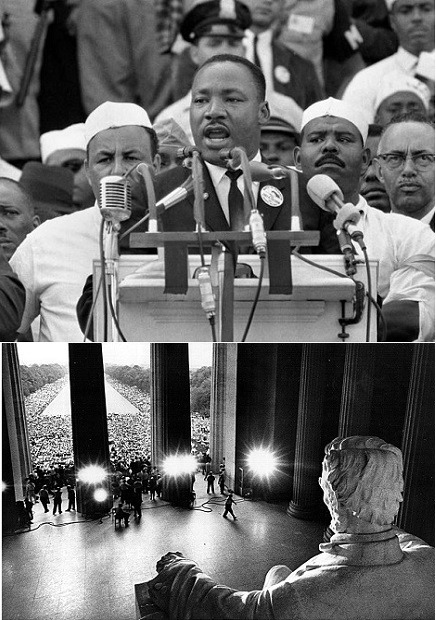
Sunday, August 28, 1963 - Washington, DC
Fifty-four years ago, in what was a defining moment in our history similar to Lincoln’s Gettysburg Address, Rev. Martin Luther King, Jr. stepped up to the podium, taking his place as the sixteenth and final scheduled speaker, at the historic March on Washington for Jobs and Freedom. A massive crowd of 250, 000 travel weary, wilting people of all races sat or stood in the hot summer sun, eager for his words and listening with rapt, undivided attention. With the event being broadcast nationally on television and radio, millions more listened to what was then believed to be the first “I have a dream” refrain. But my family and I had heard the speech, nearly verbatim, two months prior, at the Great March On Detroit where we had marched with Dr. King and members of his Southern Christian Leadership Conference and over 200,000 marching Detroiters down Woodward Avenue to Cobo Hall Convention Arena, the final destination of the march. As we had been told by my cousin, Bernard Lee, personal assistant and road manager to Dr. King, the Detroit march would be where they would “road test” the speech in advance of the Washington event.
But in both the Detroit speech and the one in Washington, Dr. King spoke of much more than “a dream” on that hot August summer afternoon. In memorable phrases laced with brilliantly constructed, visual metaphors, and borrowing portions of his opening from Lincoln’s Gettysburg Address, Rev. Martin Luther King Jr. confronted America with self-evident truths about racial inequality and the suffering of the American Negro that had gone too long ignored. With his voice soaring with passion, and reaching deep inside for the Baptist preacher within him, he succinctly brought the founding fathers’ own words into modern society, stating: “…one day this nation will rise up and live out the true meaning of its creed, 'We hold these truths to be self-evident, that all men are created equal.”

OPENING OF THE SPEECH:

MLK:
“I am happy to join with you today in what will go down in history as the greatest demonstration for freedom in the history of our nation. Five score years ago, a great American, in whose symbolic shadow we stand today, signed on a lonely island of poverty in the midst of a vast ocean the
Emancipation Proclamation
This momentous decree came as a great beacon of hope to millions of slaves, who had been seared in the flames of withering injustice. It came as a joyous daybreak to end the long night of their captivity. But one hundred years later, the Negro still is not free.
One hundred years later the life of the Negro is still sadly crippled by the manacles of segregation and the chains of discrimination. One hundred years later, the Negro lives on a lonely island of poverty in the midst of a vast ocean of material prosperity. One hundred years later, the Negro is still languishing in the corners of American society and finds himself an exile in his own land. So we have come here today to dramatize a shameful condition."
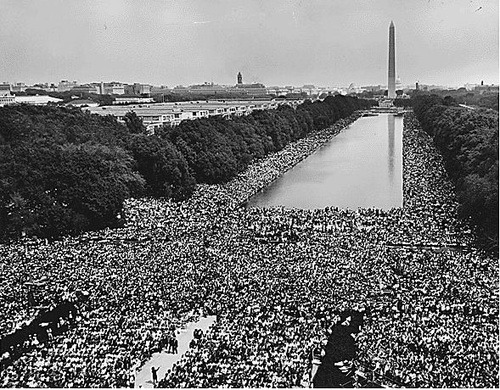
Many consider this speech to be his greatest, with specific reference to his searingly emotional declarations: “I have a dream that one day my four little children will be judged by the content of their character and not the color of their skin…”. and "...Free at last, free at last. Thank God Almighty, we’re free at last." It has been named by more than one source one of the greatest speeches of the 20th Century. But what I was most impressed by in this powerful oratory was his “bad check” metaphor, as relating to economic justice. In likening the Negro’s plight to an unfulfilled promise, a “promissory note” written by the founding fathers and reneged on by their successors, he drove home his point dramatically and with stunning precision. Pausing deliberately and intermittently between carefully selected words and phrasing, visually taking the full measure of every person before him as well as millions of his listeners world-wide, Rev. Martin Luther King Jr. solidified his well-earned reputation as one of the greatest orators in history, boldly declaring, as his thunderous words rang out magnificently over powerful speakers:
MLK: “…In a sense, we have come to our nation’s Capital to cash a check. When the architects of our great republic wrote the magnificent words of the Constitution and the Declaration of Independence, they were signing a promissory note to which every American was to fall heir. This note was a promise that all men, yes, black men as well as white men, would be guaranteed to the inalienable rights of life liberty and the pursuit of happiness…It is obvious today that America has defaulted on this promissory note insofar as her citizens of color are concerned. Instead of honoring this sacred obligation, America has given its colored people a bad check, a check that has come back marked "insufficient funds”.
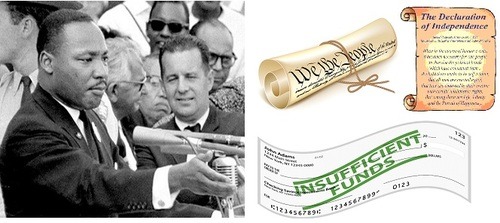
MLK: "But we refuse to believe that the bank of justice is bankrupt. We refuse to believe that there are insufficient funds in the great vaults of opportunity of this nation. So we have come to cash this check, a check that will give us upon demand the riches of freedom and security of justice.”
President Kennedy, along with the rest of the nation, watches the event and King's speech from the White House.
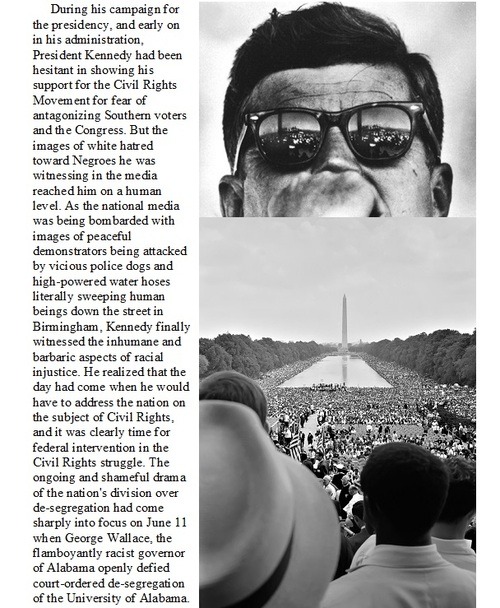
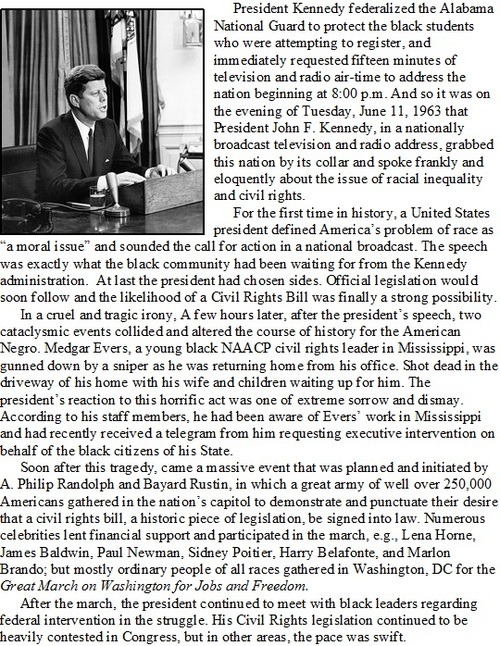

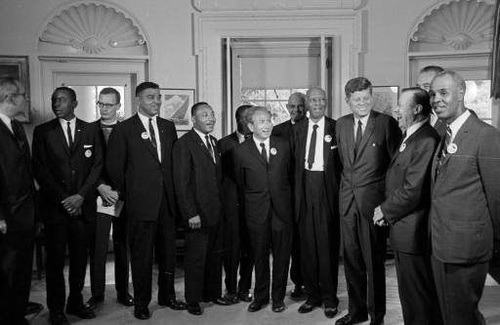
From left, Whitney Young, National Urban League; Dr. Martin Luther King, Jr., Southern Christian Leadership Conference; John Lewis, Student Non-violent Coordinating Committee; Rabbi Joachim Prinz, American Jewish Congress; Dr. Eugene P. Donnaly, National Council of Churches; A. Philip Randolph; President Kennedy; AFL-CIO United Auto Workers vice president, Walter Reuther; Vice-President Lyndon Johnson , rear, and Roy Wilkins, NAACP.

Bayard Rustin and Cleveland Robinson
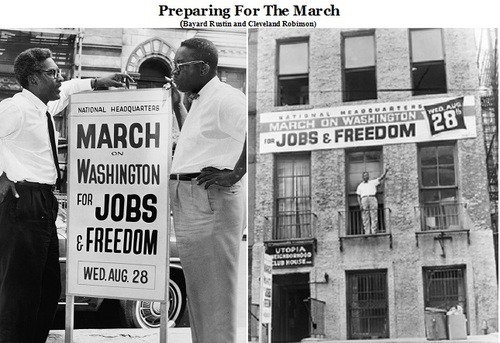
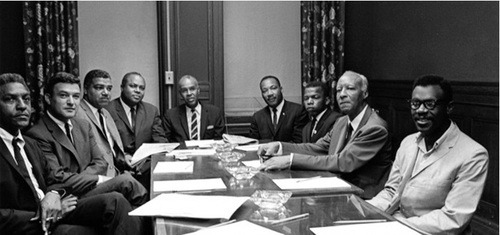


During the months of planning for the march, Rev. Martin Luther King Jr. and his SCLC traveled across the country with fundraising efforts. During a visit to Los Angeles, actor Paul Newman wrote the first donation check and was quickly joined by other supporters. In this photo by Harry Adams Dr. King and Ralph Abernathy are joined by actors, Anthony Franciosa, Paul Newman, Marlon Brando, JoAnne Woodward, singer, Polly Bergen, and Sammy Davis Jr.

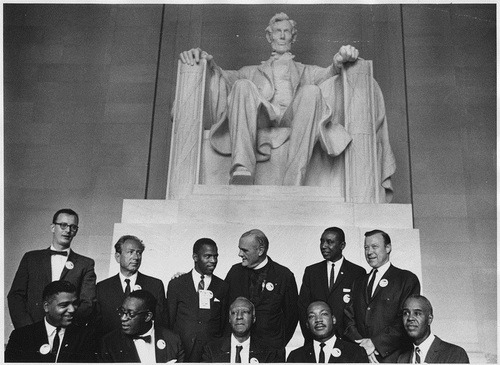
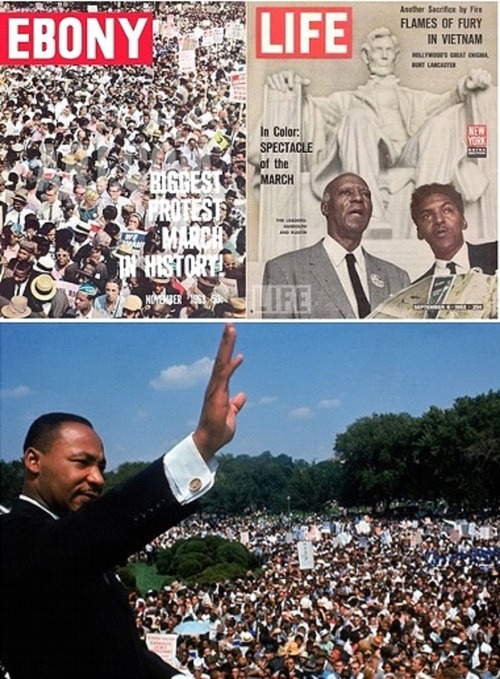
VIDEO/AUDIO of The Speech
"We have also come to his hallowed spot to remind America of the fierce urgency of “Now”. This is not the time to engage in the luxury of cooling off or to take the tranquilizing drug of gradualism.
Now is the time to make real the promise of democracy. Now is the time to rise from the dark and desolate valley of segregation to the sunlit path of racial justice. Now is the time to lift our nation from the quicksands of racial injustice to the solid rock of brotherhood. Now is the time to make justice a reality to all of God's children. It would be fatal for the nation to overlook the urgency of the moment and to underestimate the determination of its colored citizens. This sweltering summer of the colored people's legitimate discontent will not pass until there is an invigorating autumn of freedom and equality. Nineteen sixty-three is not an end but a beginning. Those who hope that the colored Americans needed to blow off steam and will now be content will have a rude awakening if the nation returns to business as usual. There will be neither rest nor tranquility in America until the colored citizen is granted his citizenship rights. The whirlwinds of revolt will continue to shake the foundations of our nation until the bright day of justice emerges. We can never be satisfied as long as our bodies, heavy with the fatigue of travel, cannot gain lodging in the motels of the highways and the hotels of the cities. We cannot be satisfied as long as the colored person's basic mobility is from a smaller ghetto to a larger one. We can never be satisfied as long as our children are stripped of their selfhood and robbed of their dignity by signs stating "for white only." We cannot be satisfied as long as a colored person in Mississippi cannot vote and a colored person in New York believes he has nothing for which to vote. No, we are not satisfied and we will not be satisfied until justice rolls down like waters and righteousness like a mighty stream. I am not unmindful that some of you have come here out of your trials and tribulations. Some of you have come from areas where your quest for freedom left you battered by storms of persecutions and staggered by the winds of police brutality. You have been the veterans of creative suffering. Continue to work with the faith that unearned suffering is redemptive. Go back to Mississippi, go back to Alabama, go back to South Carolina go back to Georgia, go back to Louisiana, go back to the slums and ghettos of our modern cities, knowing that somehow this situation can and will be changed. Let us not wallow in the valley of despair. I say to you, my friends, we have the difficulties of today and tomorrow. I still have a dream. It is a dream deeply rooted in the American dream. I have a dream that one day this nation will rise up and live out the true meaning of its creed. We hold these truths to be self-evident that all men are created equal. I have a dream that one day out in the red hills of Georgia the sons of former slaves and the sons of former slave owners will be able to sit down together at the table of brotherhood. I have a dream that one day even the state of Mississippi, a state sweltering with the heat of oppression, will be transformed into an oasis of freedom and justice. I have a dream that my four little children will one day live in a nation where they will not be judged by the color of their skin but by their character. I have a dream today. I have a dream that one day down in Alabama, with its vicious racists, with its governor having his lips dripping with the words of inter-postion and nullification; that one day right down in Alabama little black boys and black girls will be able to join hands with little white boys and white girls as sisters and brothers. I have a dream today. I have a dream that one day every valley shall be engulfed, every hill shall be exalted and every mountain shall be made low, the rough places will be made plains and the crooked places will be made straight and the glory of the Lord shall be revealed and all flesh shall see it together. This is our hope. This is the faith that I will go back to the South with. With this faith we will be able to hew out of the mountain of despair a stone of hope. With this faith, we will be able to transform the jangling discords of our nation into a beautiful symphony of brotherhood. With this faith, we will be able to work together, to pray together, to struggle together, to go to jail together, to climb up for freedom together, knowing that we will be free one day. This will be the day when all of God's children will be able to sing with new meaning "My country 'tis of thee, sweet land of liberty, of thee I sing. Land where my father's died, land of the Pilgrim's pride, from every mountainside, let freedom ring!" And if America is to be a great nation, this must become true. So let freedom ring from the hilltops of New Hampshire. Let freedom ring from the mighty mountains of New York. Let freedom ring from the heightening Alleghenies of Pennsylvania. Let freedom ring from the snow-capped Rockies of Colorado. Let freedom ring from the curvaceous slopes of California. But not only that, let freedom ring from Stone Mountain of Georgia. Let freedom ring from every hill and molehill of Mississippi and every mountainside. When we let freedom ring, when we let it ring from every tenement and every hamlet, from every state and every city, we will be able to speed up that day when all of God's children, black men, and white men, Jews and Gentiles, Protestants and Catholics, will be able to join hands and sing in the words of the old spiritual, "Free at last, free at last. Thank God Almighty, we’re free at last."
3 notes
·
View notes
Text

https://tvtropes.org/pmwiki/pmwiki.php/Film/AmericanHistoryX
American History X by Christopher Janda
American History X is an extremely difficult movie to watch, but through those difficult scenes it makes a powerful statement about hate. The movie opens with Derek Vinyard (Edward Norton) murdering two African-Americans who broke into his car. He is arrested and sentenced to three years in prison. Later, we learn that Derek and his brother, Daniel (Edward Furlong), have been members of a hate group called the D.O.C. The African-Americans that Derek murdered were breaking into his car out of revenge for a basketball game earlier. This showed how quickly hate can spiral. A simple basketball game ultimately led to the death of two men and another spending three years in prison.

http://www.fanpop.com/clubs/american-history-x/images/38821307/title/edward-norton-derek-vinyard-photo
We discover that the source of Derek’s hate is the murder of his father. A firefighter, his father was shot and killed by an African-American while fighting a fire. Derek appears on the news at the time and talks about it but spends most of the interview spewing hate speech. We later learn that Derek’s father was intolerant of African-Americans as well and influenced Derek’s opinion even before his murder.

https://www.imdb.com/title/tt0120586/mediaviewer/rm2049182208
While in prison Derek works in the laundry room with an African-American man, Lamont (Guy Torry). Derek does not say anything to Lamont at first, but after a while he has a falling out with the skinhead gang in the prison (to put it mildly), and he eventually opens up to his coworker. While they are talking, Derek learns that the reason Lamont is serving a six-year sentence is because he stole a television. However, after running out of the store he passed a doughnut shop and ran into three cops. One of them grabbed his arm, and he dropped the television on the officer’s foot, breaking their foot. He was charged with assault. Derek begins to realize the social injustices that have been keeping the African-American community down.

https://imgur.com/gallery/3IETqbT
This conversation between Derek and Lamont was an important moment because it shined a light on the racial inequalities within our justice system. On one side of the table we have Derek, a white man who received a three-year sentence for murdering two African-American’s. On the other side we have Lamont, an African-American who received a six-year sentence for stealing a television. These kinds of racial inequalities still plague our justice system today. For example, according to the American Civil Liberties Union, African-Americans are 3.73 times more likely to be arrested for marijuana possession than white people.1 According to the NAACP African-Americans are six times more likely to be arrested for drugs (despite using drugs at a similar rate) and five times more likely to be arrested for a crime in general.2
The movie continues with Derek’s release as a reformed man, but I won’t go any further to avoid spoiling the movie for anyone.
1. https://www.aclu.org/gallery/marijuana-arrests-numbers
2. https://www.naacp.org/criminal-justice-fact-sheet/
0 notes
Text
First 100 Days of Trump: I’m Rethinking the Bush Years
By C. Stone Brown
After watching a member of congress calmly spew white supremacist ideology to a national audience without any fear of reprimand from members of his own party, I have to admit, I long for the ‘good old days’ when a republican, such as George W. Bush would stand up in opposition to overt racism by a member of his party.
Indeed, I never thought I would utter these words: I want to ‘Make America great again’ like the George W. Bush years, I think.
Trump’s America has brought me to rethink the Bush years, especially after reading the tweet of Iowa republican Rep. Steve King, who took to twitter to let the world know he aligns himself with white nationalist Geert Wilders, who lost his bid to become Dutch prime minister. “Wilders understands that culture and demographics are our destiny,” King tweeted. “We can't restore our civilization with somebody else's babies.” No, that wasn’t a David Duke quote, but from a current member of Congress.
Apparently, King couldn’t wait to get an opportunity to explain himself on CNN’s Chris Cuomo show the next morning.
Pulling from Trump’s playbook, King didn’t apologize. In fact, he doubled-down.
“Well, of course I meant exactly what I said as is always the case. And to expand on that a little further, I've been to Europe and I've spoken on this issue and I've said the same thing as far as ten years ago to the German people and any population of people that is a declining population that isn't willing to have enough babies to reproduce themselves. And I've said to them, "You can't rebuild your civilization with somebody else's babies. You've got to keep your birth rate up and that you need to teach your children your values. And in doing so, then you can grow your population and you can strengthen your culture, and strengthen your way of life. That's not happening in any of the western European countries.”
Before I get jumped on by progressives for the blasphemy of putting “Great” and “George W. Bush” in the same sentence, I’m not attempting to re-write the history of the Bush years.
In fact, there are no “alternative facts” that would change the Bush administration’s fabrication of Iraqi “weapons of mass destruction,” the illegal secret prisons overseas, the innocent lives lost from drone strikes – creating more terrorists, the massive tax cuts for the top 1 percent, the Wall St deregulations that put our economy on the brink of a depression, and the millions of Americans who lost their homes to foreclosure. I could go on.
But as an American, and 60+ days into the Trump presidency, I don’t ever recall questioning Bush’s loyalty to America. And as an African American, I never wondered if the country elected a racist demagogue, sexist and xenophobe to live in the White House. And if given the choice, I would take the personal flaw of Bush’s arrogance, over Trump’s narcissism because the latter puts us all at risk.
I’m comfortable with this assessment because I observed Bush for eight years. And while I didn’t agree with most of his polices or world view, he didn’t have a white nationalist (Steve Bannon) advising him every day. In fact, I watched Bush select blacks, Hispanics and women to powerful positions in his cabinet- a cabinet that resembled America.
I also remember his forceful statements and press conferences to the American people that despite our military actions in Muslim countries, Muslim Americans – are Americans, and should be treated with the same respect as any other Americans.
Bush also faced a similar “Steve King” moment during his presidency, when he was faced with the Trent Lott controversy. It underscores a common refrain repeated in political commentary that the “republicans” of today, aren’t really “republicans.”
In 2002, Lott, the Mississippi Senator was majority leader when Bush took office. While attending the 100th birthday party of good friend Sen. Strom Thurmond, Lott gave a speech praising Thurmond’s 1948 segregationist platform presidential campaign.
''I want to say this about my state: When Strom Thurmond ran for president, we voted for him. We're proud of it. And if the rest of the country had followed our lead, we wouldn't have had all these problems over all these years, either,'' said Lott [who then dropped the mic].
That “mic” drop echoed throughout the halls of Congress. For weeks, both Republicans in the House and Senate were feeling the heat to make a statement condemning Lott, while civil rights leaders were calling for Lott to resign. Kweisi Mfume, then CEO of the NAACP was one of them, calling the remarks (NYT 2002) the ''kind of callous, calculated, hateful bigotry that has no place in the halls of this Congress.'' Ultimately, it wasn’t civil rights leaders or Lott’s colleagues that would determine his fate; it would be the leader of the Republican Party. Would Bush give Lott political cover or rebuke him?
While speaking in Philadelphia, Bush addressed the controversy. "Any suggestion that the segregated past was acceptable or positive is offensive, and it is wrong," said Bush. "Recent comments by Senator Lott do not reflect the spirit of our country. He has apologized, and rightly so.” What was most striking about Bush’s comments is he mentioned Lott by name, which is unusual in Washington. The lack of support from Bush would ultimately lead to Lott stepping down.
When Trump was asked why he supported King in 2014, he had nothing but praise for the congressman. “I’m here to support Steve King—a special guy, a smart person with, really, the right views on almost everything."
Although we will never know, I can’t help but wonder how George W. Bush would have handled Steve King.
1 note
·
View note
Text
Day 8 - Homecoming!
Day 8 started in the city of Jackson, Mississippi, the city I was born in. As we drove from the hotel to the home of Medgar Evers, it was weird and both very familiar as we drove down roads that as a child I can vividly remember. Passing the Jackson Mall where my mom and I used to go to Piccadilly Restaurant, and I would order the same thing everytime. Rice and gravy, chopped steak, corn, green beans, soft butter roll.
We arrived at the Medgar Evers home. While I was familiar with the home because it was across the street from my great grandmother’s house on my step father’s side and the home next to where Byron De La Beckwith hid and shot Medgar Evers.
If you are not familiar with the story of Medgar Evers, he was a civil rights activist born in Mississippi in 1925, and worked as the Secretary of the NAACP. Medgar was a World War 2 Veteran and college graduate. He became active in the civil rights movement in the 1950’s.
Following the 1954 ruling of the United States Supreme Court in Brown v. Board of Education that segregated public schools were unconstitutional, Medgar challenged the segregation of the state supported public University of Mississippi. He applied to law school there but was declined because of his race. He worked to further voting rights, economic opportunity, access to public facilities, and other changes in the segregated society.


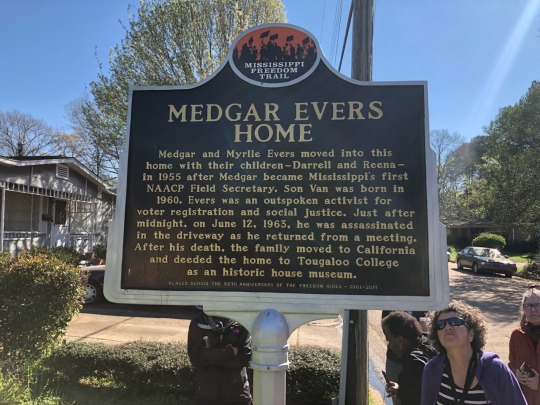
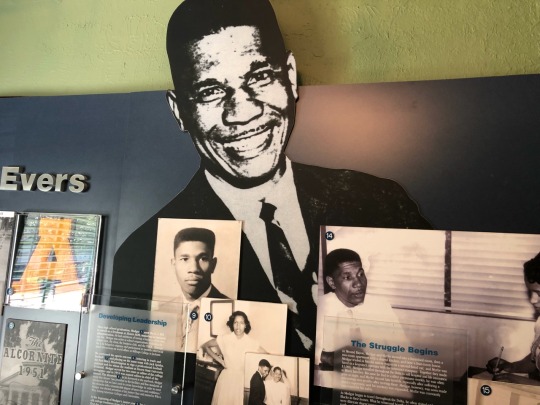
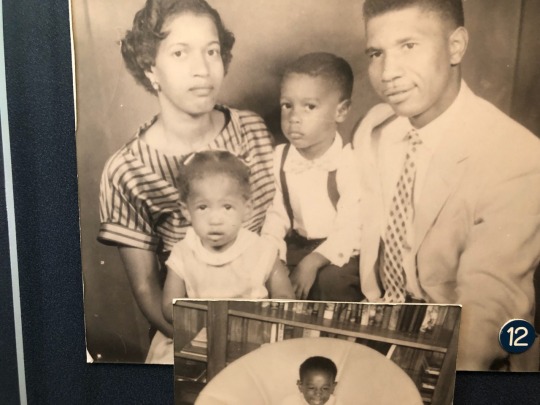
It was shortly after that he was asked to take on his role at the NAACP. While I have been familiar with the story of Medgar Evers, I had never had an opportunity to personally go into the home and hear from someone that new Medgar personally to explain the story of what happened or to see the house for that matter. I learned that Medgar had come home from a meeting that night, but in that meeting Byron De La Beckwith had been in the back of the room during the meeting. This was not completely unusual because there were often times whites in meetings during that time. He went and waited for Medgar to get home.
To back up some, Medgar upon coming to Jackson specifically chose the house he did because it was in a development being built by a black developer and off the highway some. He also chose the house he did because it was nestled in between two homes, and he specifically asked for the door to be placed on the side of the house under the carport versus in the front of the house for safety. We were told that his family was always taught to not get out of the car unless they did so from under the carport and that they were taught to get out of the car on the passenger side so that the car and the house acted as a shield.
We also learned that Medgar had taught his family to often sit on the floor while watching TV below window level, and in the bedrooms the mattresses had been placed on the floor as not to be at window level. These were precautions the family took given the times and numerous threats that Medgar and his family received.
When Medgar came home from the meeting our tour person told us that his wife heard her husband pull into the driveway but after a while Medgar did not come in. She heard a loud noise that sounded like a gunshot and as they had been taught, her and the kids crawled on the floor heading towards the bathroom. Medgar had always taught his family that the safest place in the house should they hear shots or something should happen was the bathroom and so they were headed there.
As Medgar was getting boxes of shirts out of the trunk for a rally the next day in Jackson, he was shot on the right side in the back just below his shoulder. The bullet passed through him and into the house hitting the refrigerator and landing in the kitchen. You can look at the refrigerator today and see the bullet mark today. Oddly enough on the night that Medgar was shot, his family was inside watching John F. Kennedy on television give a speech.
Medgar like so many other activist in the civil rights struggle was gunned down fighting for equality. Byron De Le Beckwith left the gun where he was which it was later found.
The gun is now on display today at the Civil Rights Museum in Jackson which we visited today. Below is the rifle that he used to gun down Medgar Evers.


Byron was tried twice in 1964, but an all white jury failed to reach a conviction resulting in two hung juries. In 1994 he was tried by the state of Mississippi in a new trial based on new evidence. He was convicted of murder and sentenced to life in prison. Seven years after being convicted of killing Medgar Evers, he died in prison in 2001 at the age of 80.
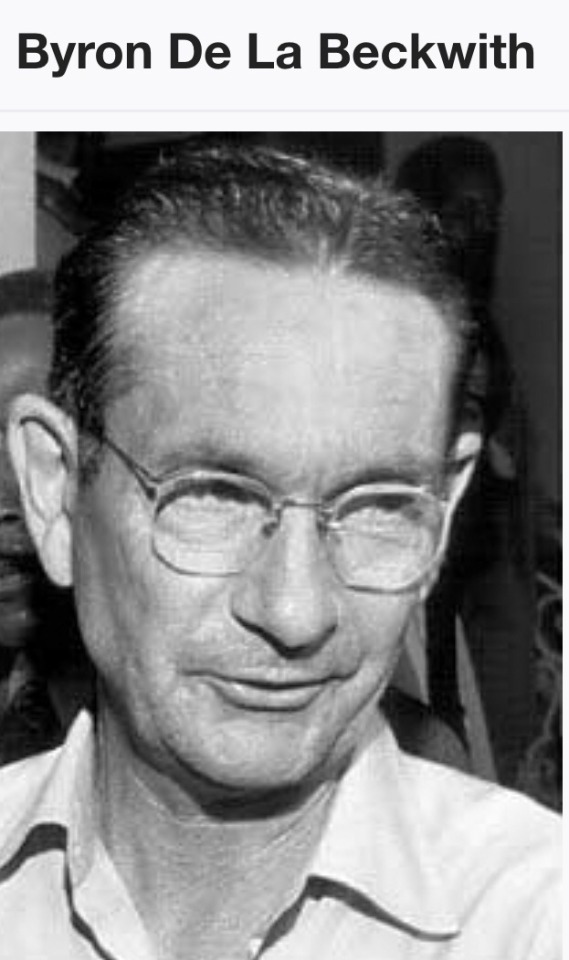

After visiting the Medgar Evers home, we left and got a chance to visit the Mississippi Civil Rights Museum. This museum is amazing and has a ton of history dating back from slavery through the civil rights movement up to today. I would highly recommend that if you haven’t had a chance to see it, if you are ever in the south and Jackson specifically that you do.
There’s so much to share during these but I continue to try and share the things that most impacted me from the day.
We are winding down on this journey and I’ve been able to experience so much. Tomorrow we will be in Selma, Alabama for Jubilee and then again on Sunday for a bit before boarding a plane for home in Atlanta.
Hard to believe there is more to this journey but I’m looking forward to it!
Let the journey continue!
0 notes
Text
SNL is wrong — Trump is far worse than Bush

(CNN)"Saturday Night Live" opened last night with a hilarious sketch of Will Ferrell reprising his role as President George W. Bush. Having worked on SNL's production staff for most of the Bush years, I can say that this was one of the best Bush sketches the show has served up in terms of laughs. But I have to disagree with SNL's implication that Bush was as bad, if not worse, of a president as Donald Trump. It's no comparison -- Trump is far worse.
The show then turned to the politics of today. "Bush" boasted that his approval ratings are at an all-time-high, referring to recent news that his favorability has drastically increased since he left office. (When Bush left office, he was saddled with a dismal 33% favorability rating.) Ferrell then joked, "That's right. Donny Q. Trump came in, and suddenly I'm looking pretty sweet by comparison. At this rate, I might even end up on Mount Rushmore, right next to Washington, Lincoln and I want to say, uh, Kensington?"
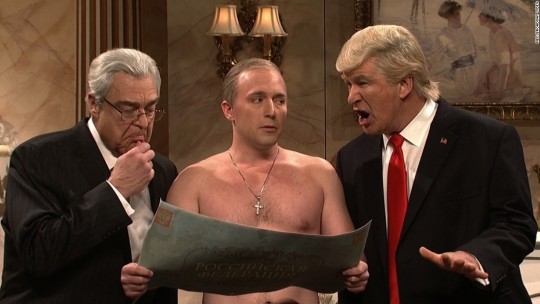
But then SNL pivoted to remind us how bad Bush was as President, with Ferrell laughingly reminding us: "I was really bad -- like historically not good."
"Don't forget: We're still in two different wars that I started," he added. Ferrell then paused before delivering a killer line: "What has two thumbs and created ISIS? This guy!" and pointing at himself.
"Bush" also highlighted how awful the economy was when he left office. He held up a chart that showed the stock market tanking and joked: "Now I'm no 'economer' but even I know that was 'no bueno.'"
SNL was right that Bush had earned his horrible approval ratings. But what SNL missed -- perhaps even intentionally to spark a debate -- is how horrific Trump is in terms of trying to divide us by race, religion and even immigration status as compared to Bush.
For example, during Trump's presidential campaign he despicably ginned up hate against Muslims with his comment that he thinks "Islam hates us" and his call for "a total and complete shutdown of Muslims entering the United States." And as President, he has tried to implement an immigration ban primarily directed at a number of Muslim majority nations.
What a contrast to Bush and his words only weeks after the 9/11 terror attack committed by Al Qaeda. With the nation watching, Bush didn't try to stoke hate against Muslims. Instead, he declared: "The enemy of America is not our many Muslim friends." Bush then added about Islam, "Its teachings are good and peaceful, and those who commit evil in the name of Allah blaspheme the name of Allah."

Trump has also demonized Mexicans and other immigrants countless times during his campaign and as President. Indeed, Trump literally kicked off his campaign in 2015 declaring falsely that Mexico was sending "rapists" to America. Trump recently called Africa and Haiti "shitholes."
Compare those words to Bush's during a 2006 speech on immigration, in which he praised undocumented immigrants -- rather than demonizing them like Trump -- and noted that the "vast majority" are "decent people who work hard, support their families, practice their faith, and lead responsible lives." Bush added that we are "a nation of immigrants, and we must uphold that tradition, which has strengthened our country in so many ways."
And while Trump rejected the invitation to speak at the NAACP convention last year, Bush delivered addresses to the organization both as a candidate in 2000 and as President in 2006. Unlike Bush, Trump made it clear he had no interest in reaching out to people beyond his base.
Beyond that, Trump has truly emboldened the vilest voices in America by retweeting an alt-right conspiracy theorist and revoltingly referring to those who marched with the white supremacists and Neo-Nazis in Charlottesville as "fine people."
Join us on Twitter and Facebook
These actions stand in contrast to Bush who, just days after 9/11, traveled to the Islamic Center of Washington, DC and made it clear that there would be zero tolerance for attacks on American Muslims. "That should not and that will not stand in America," he said. And more recently, in October, Bush passionately slammed the racists: "Bigotry or white supremacy in any form is blasphemy against the American creed."
Bush, as SNL rightly reminded us, was truly awful in certain areas. But overall, Trump is far, far worse for our nation.
More From this publisher : HERE ; This post was curated using : TrendingTraffic
=> *********************************************** See Full Article Here: SNL is wrong — Trump is far worse than Bush ************************************ =>
Sponsored by our friends from Met001.biz
=>
This article was searched, compiled, delivered and presented using RSS Masher & TrendingTraffic
=>>
SNL is wrong — Trump is far worse than Bush was originally posted by A 18 MOA Top News from around
0 notes
Link
Discrimination has a long history in our country. Sadly, discrimination has historically negatively affected minority groups such as women and African Americans. One of the most recognizable names and leaders of the civil rights movements is Martin Luther King Jr. We spent about a week watching videos and listening to lectures to learn about King’s fight for equal rights, his peaceful methods, and his religious life. Specifically mentioned was his background as a preacher and his roots in the Black Church. King was a great speaker and influenced people from places and backgrounds making significant progress towards equal rights for African Americans and women both legally and culturally.
In today’s world, roughly 50 years after King’s death, civil rights and black religious leaders are hoping to have a similar effect on people as King. This time it is an urge for people, specifically African Americans, to remain at home once the state of Georgia reopens. The early numbers of COVID 19 have heartbreakingly shown that minority groups, such as African Americans, have been significantly more affected. The Center for Disease Control shows that of all COVID 19 related deaths, about 20% are African Americans, but African Americans only make up about 13% of the total population. It is unclear as to why the numbers are so skewed, but my first assumption is the lack of accessibility to PPE and my second assumption is racial bias within the healthcare system. While the numbers are still climbing and we are not past this crisis just yet, some states are making moves to reopen businesses, Georgia is one of them.
A coalition has been brought together by Reverend Al Sharpton’s National Action Group and the Conference of National Black Churches to assist in building a message and sharing that with the African American community. This group includes leaders from the NAACP, the National Urban League and the National Lawyers' Committee for Civil Rights Under Law. They are frustrated and disappointed that Georgie is not placing the health and safety of African Americans, about 33% of the state’s population, as a priority over the economy. There is one particular government leader that is also not happy and supports the coalition’s message, that is Atlanta Mayor Keisha Lance Bottom. I saw Mayor Lance Bottom speak live on my local news network, KTVU 2, and she stated she is taking any opportunity to express her concerns and request the people of Atlanta and everywhere else to continue to shelter in place. She has continuously expressed her dissatisfaction with Governor Brian Kemp’s decision to reopen even as infections and deaths continue to rise. These leaders are taking a similar approach as King, doing things through speeches and messages without violence and riots. The coalition and Mayor Lance Bottom are pleading to everyone, specifically the African American community, to continue to stay home despite the ease in restrictions.
It is an interesting time in our world and although we are a long time removed from slavery, segregation, and the 3/5th rule, somehow it seems that discrimination just does not go away. In today’s society, discrimination is commonly seen as police brutality and recently I saw a video on Twitter of a white women calling the police on a group of young black men that were renting an AirBnB and she claimed they were breaking into the complex. Who would have thought we would have seen it in the form of a worldwide pandemic. Now, I understand the stress decision makers are under during these times and they are making difficult choices, but reopening a state to get your economy moving again does not seem right when you look at the data. The second largest demographics of Georgia is getting disproportionately affected by this virus and yet it does not seem like it Governor Kemp is taking that seriously.
I applaud the civil rights leaders, the religious leaders, and Mayor Lance Bottom for seeing the facts and acknowledging that there is still work to be done before a reopening should happen. I hope that all people, not just the African American community, listen to them and stay at home until the data shows significant improvement. What signs would you want to see prior to a reopening of the country?
0 notes